
Green Car Future
The future's here, and it's shaping up to be a wild ride!

VW ID: The Difference Between ACC and Travel Assist (Is There One?)
In the current age, when we’re buying a new car, we tend to focus a lot of our attention on features and packages. When we were all buying internal combustion engine (ICE) cars, besides digital and technology features, we also took engine and mechanical features into account: cylinders, displacement, horsepower, torque, miles per gallon, etc. There’s been a shift, however, as we move toward electric cars.
With electric cars, we do care about range and battery capacity of course, but we are more fascinated by the software and digitally-driven features that dominate how the car works. Electric cars run so much more dependently on digital algorithms rather than mechanical power, and so what’s really exciting about them is what they can offer us on that front.
The VW ID.3 and VW ID.4 are part of a growing family of electric cars from Volkswagen. They also bring a lot of interesting technology to bear , including their much lauded Adaptive Cruise Control (ACC) system, and Travel Assist features.
The trouble with these 2 features, however, is that many people have trouble telling the difference between them? Are they just 2 names for the same feature? Is there a real difference? Is one for the ID.3 and the other for the ID.4?
In today’s blog, we want to answer these core questions and others.
ACC and Travel Assist – Two Features Explained
First of all, let’s deal with one important part of the core questions, which is that ACC and Travel Assist are two distinct things and are not simply the same thing renamed or repackaged. They are, however, closely related to one another , which is why there is some confusion about them in the first place.
Adaptive Cruise Control (ACC)
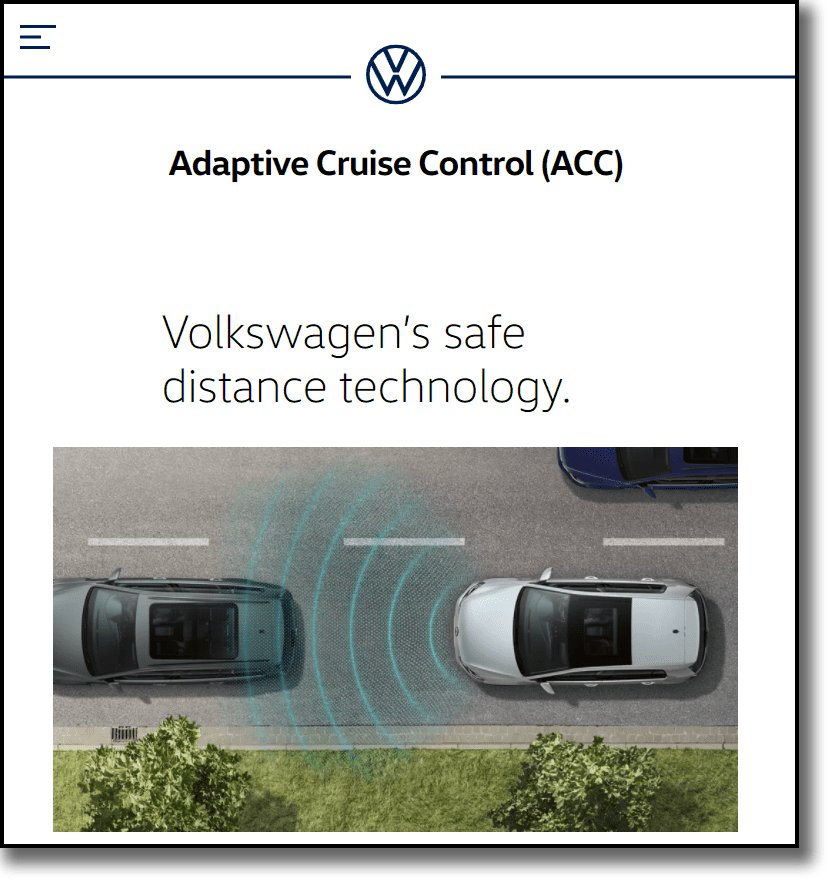
This is the older of the two features and is present in both the ID.3 and ID.4 vehicles . ACC is a feature not unique to VW cars, and in other cars might be known by the same or similar name, or something like “dynamic cruise control,” or “advanced cruise control,” and so on.
In essence, ACC is designed to maintain the driver’s speed, but then also adapt the speed according to the traffic conditions ahead. It does this both through braking and acceleration .
Early versions of ACC are limited to these functions, but the latest versions have also been augmented with a radar sensor , a camera and navigation data to help manage how it works according to local speed limits. The navigation data helps the car to calculate any required speed reductions required before hitting bends, roundabouts and intersections.
For clarity’s sake, we should say that ACC is by no means an autonomous driving system. The best way to think of ACC is as a much more advanced and updated version of cruise control that many cars have had for the past few decades.
Travel Assist
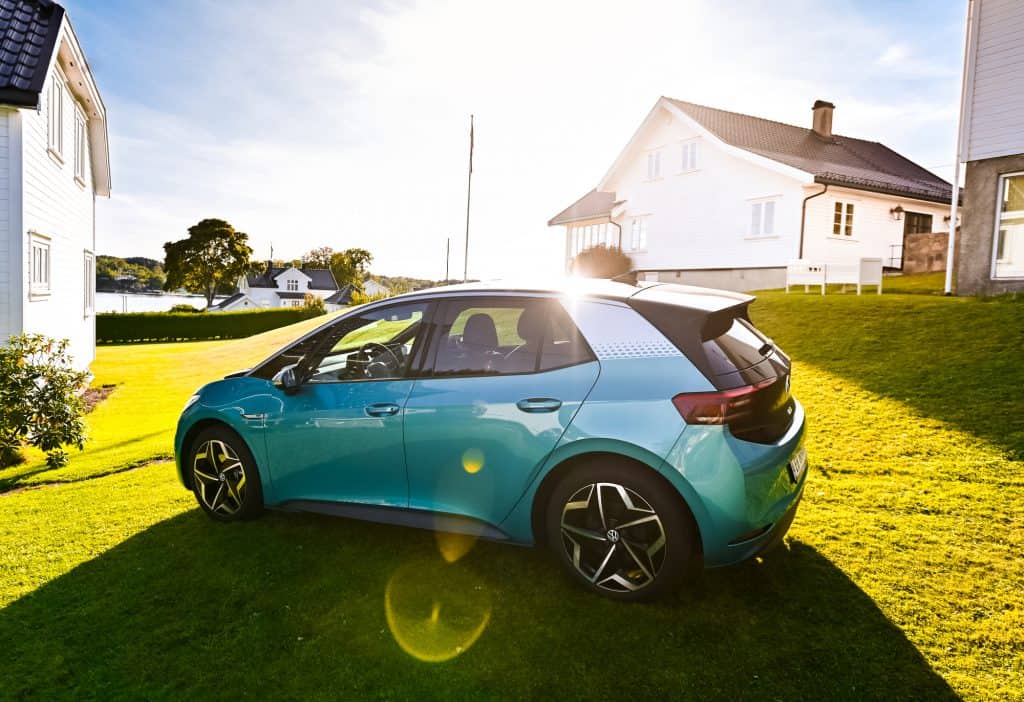
Now we come onto the Travel Assist feature. If ACC is an evolution of cruise control, then Travel Assist is a further evolution of ACC . More accurately, it’s a broadening of the scope of ACC to include and combine other features into a new package.
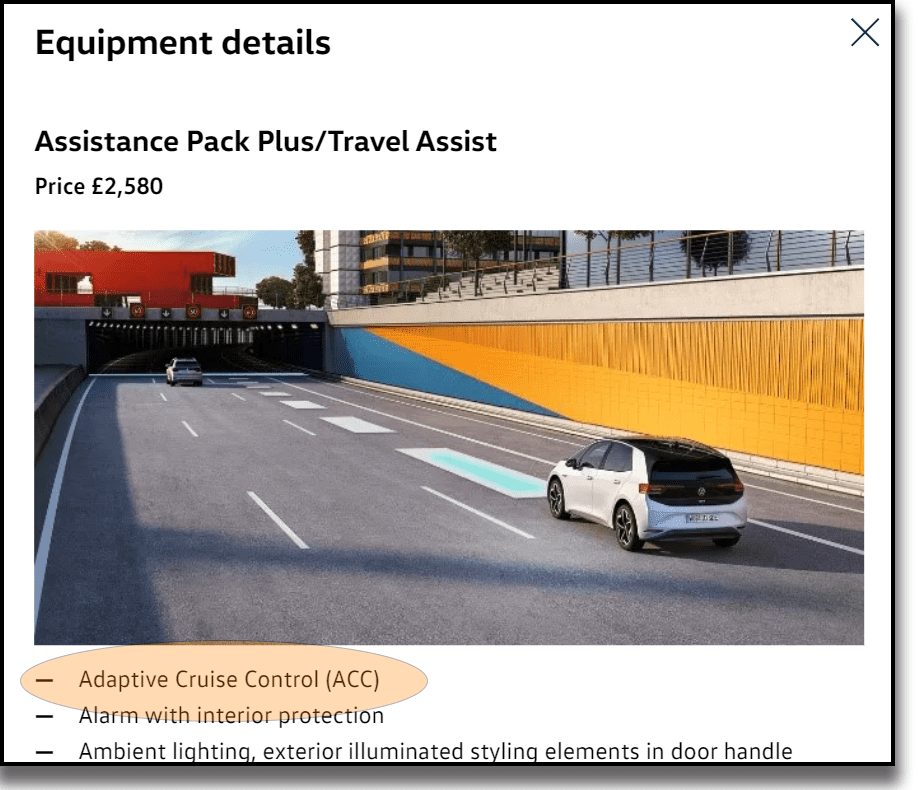
VW explains Travel Assist (also sometimes called Assistance Pack Plus) like a larger package of technology that now includes ACC. Another useful element combined into the package is lane keeping assist.
So what can Travel Assist do, exactly? The first thing to note here is that among the many functions of Travel Assist is the ACC system and its related functions. This is why people have been confused, because all Travel Assist systems include ACC, but not all VW cars with ACC have the wider Travel Assist package .
Travel Assist’s functions include (besides ACC), greater autonomous control of the accelerator, brake and steering, especially when driver inactivity is detected and the car predicts an emergency situation is coming. It’s activated by a button mounted on the steering wheel of your ID.3 or ID.4, symbolized by a car in lane with a speedometer next to it; the bottom-right button of the left-hand control cluster on the steering wheel.
When active, and assuming that the car’s sensors know and can identify the road that the car is on, that same symbol on the button will appear on the dash display as a green light. If the driver at any point applies the hydraulic brake, Travel Assist is automatically deactivated. To remain active, it requires that the driver’s hands remain on the wheel at all times.
What is “Emergency Assist”
Within the Travel Assist package you have ACC, the lane-keeping feature, and also Emergency Assist. This activates when the car detects no driver input — e.g. hands not on wheel — and a hazard perceived in the road ahead. Alternatively, if the driver is to remove their hands from the wheel, the car will first run for a few minutes without any problems .
It will then prompt the driver to return their hands to the wheel with a message on the dash display. If the driver fails to respond, an audible warning is activated.
If the driver fails to respond to the audible warning, then the car automatically enters Emergency Assist mode and will begin to slow the car down. It can even bring the car gradually to a safe and complete halt and activate the hazard lights. Imagine a scenario, for example, where a driver had a seizure or a heart attack and was left incapacitated.
The idea is that their car would be able to stop itself while also avoiding other cars around it, maintaining safe distances and speeds until that emergency mode kicked in .
ACC Vs. Travel Assist
So, now you can see that while both ACC and Travel Assist are clearly related, they bring distinct things to the table, with arguably the latter doing more for drivers and passengers, but both clearly being useful.
Surely, then, most people are clamoring to get their hands on the Travel Assist Package to upgrade their existing ACC system? It’s at this point where things start to get a bit complicated. Well, for those in the US market it’s actually quite simple. Travel Assist is a standard feature now on US models of the ID.4, but it’s the European market where things get harder .
In the UK, for instance, the ID.3 and ID.4 models all have ACC as a standard feature, but the Travel Assist features are only available on the Max trims and higher for both models. The new ID.5 SUV in the UK does have Travel Assist features as standard, as well as ACC.
What’s interesting is that there is even debate about how necessary Travel Assist is. As it happens, not everyone is clamoring to get their hands on it, with many arguing that ACC on its own is more than sufficient.
The ACC features a stop and go technology which makes heavy-traffic commutes much less tiring, and the ACC is apparently able to bring the car to a complete stop if needed .
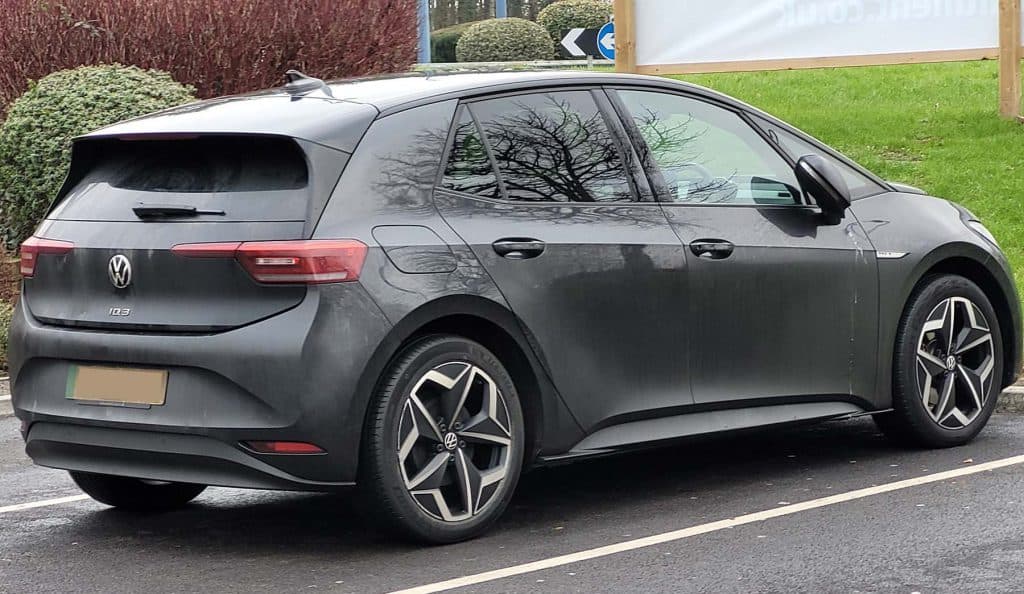
The main difference then for drivers is whether or not they want the assistance with lane keeping, steering and the emergency features. For many, it seems that these are overkill and not worth the extra money. Drivers in the US, however, it seems don’t really have to worry since it all comes as one single package.
Can I Get Travel Assist as an OTA Update?
Finally, there is a question for those with older ID models that only have ACC, and that is whether or not it’s possible to upgrade to get Travel Assist simply with an OTA update . This is similar to Tesla offering owners of its older models the ability to upgrade from standard Autopilot to the Full Self-Driving (FSD) package for a fee.
The reason that worked for Tesla is that it didn’t require the addition of any other hardware. As long as the main operating system was updated to the latest version, then it was possible to upgrade many vehicles with Autopilot without any problem.
There is a question mark over whether or not the VW ID models would be able to receive Travel Assist because of some potentially missing hardware, namely the hardware for the side assist features that help with lane keeping and steering assistance.
If that’s the case, then no OTA is possible, but if it turns out existing hardware is sufficient, then it’s certainly something VW could offer.
Related Reading: Do Any VW ID Cars Have Ventilated Seats?
Leave a comment Cancel reply
Save my name, email, and website in this browser for the next time I comment.
The 2021 Volkswagen ID. 4 ticks all the boxes, except one
The electric crossover packs in tech, plenty of range at an affordable price.
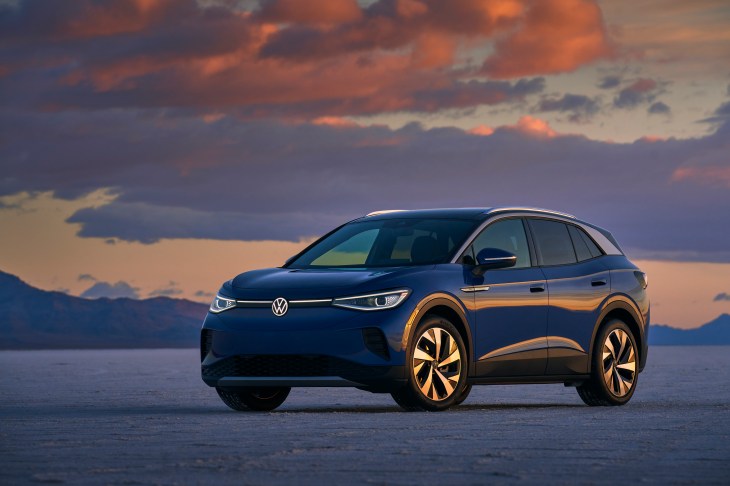
Volkswagen, once a dabbler in electric vehicles, is now betting its future on the technology. And the new Volkswagen ID.4 — a five-passenger, fully electric crossover with a starting price of $33,995 (before federal or state incentives) — is its first global effort to make EVs a mainstream product and part of its larger goal to become carbon neutral by 2050.
The upshot: The VW ID.4 offers a balanced blend of technology, comfort and design for a more affordable price and seeks to capture some of the market left vacant by the lack of an affordable Tesla Model Y. The VW ID.4 offers solid technology without being so out of this world that your average crossover buyer will balk … with one exception. The lack of seamless charging makes finding and then connecting to a third-party charging station a clunky, even complex experience.
As Mark Gillies, senior manager of Product at VW said during our interview, “We want to be the company that builds electric cars for the millions, not just for the millionaires.”
While that may be true, there are a few niggling concerns, like a somewhat laggy infotainment system, that should improve with updates coming soon, and the previously mentioned miss of seamless charging. If Volkswagen can address those problems, the VW ID.4 could take a solid bite out of the booming crossover market. But will the masses flock to a fully electric future that delivers a near-to-gasoline driving experience and become the “car for the millions?”

Image Credits: Volkswagen
The 2021 Volkswagen ID.4 crossover might be the first global, dedicated all-electric vehicle from the VW brand, but it’s not the first consumer-available electric vehicle from the VW Group as a whole. It launched the California-only Volkswagen e-Golf back in 2013 (discontinued last year), and the company’s luxury performance brand Porsche began sales of its all-electric Taycan in 2019.
When it launched, e-Golf represented more of a fringe case for the company. It was targeted specifically at the California market, where incentives for electric vehicles and charging infrastructure, as well as environmental regulations, are more robust. The ID.4, in contrast, represents one of the “most important Volkswagen debuts since the Beetle,” and it will be available across the country.
The tech that stands out
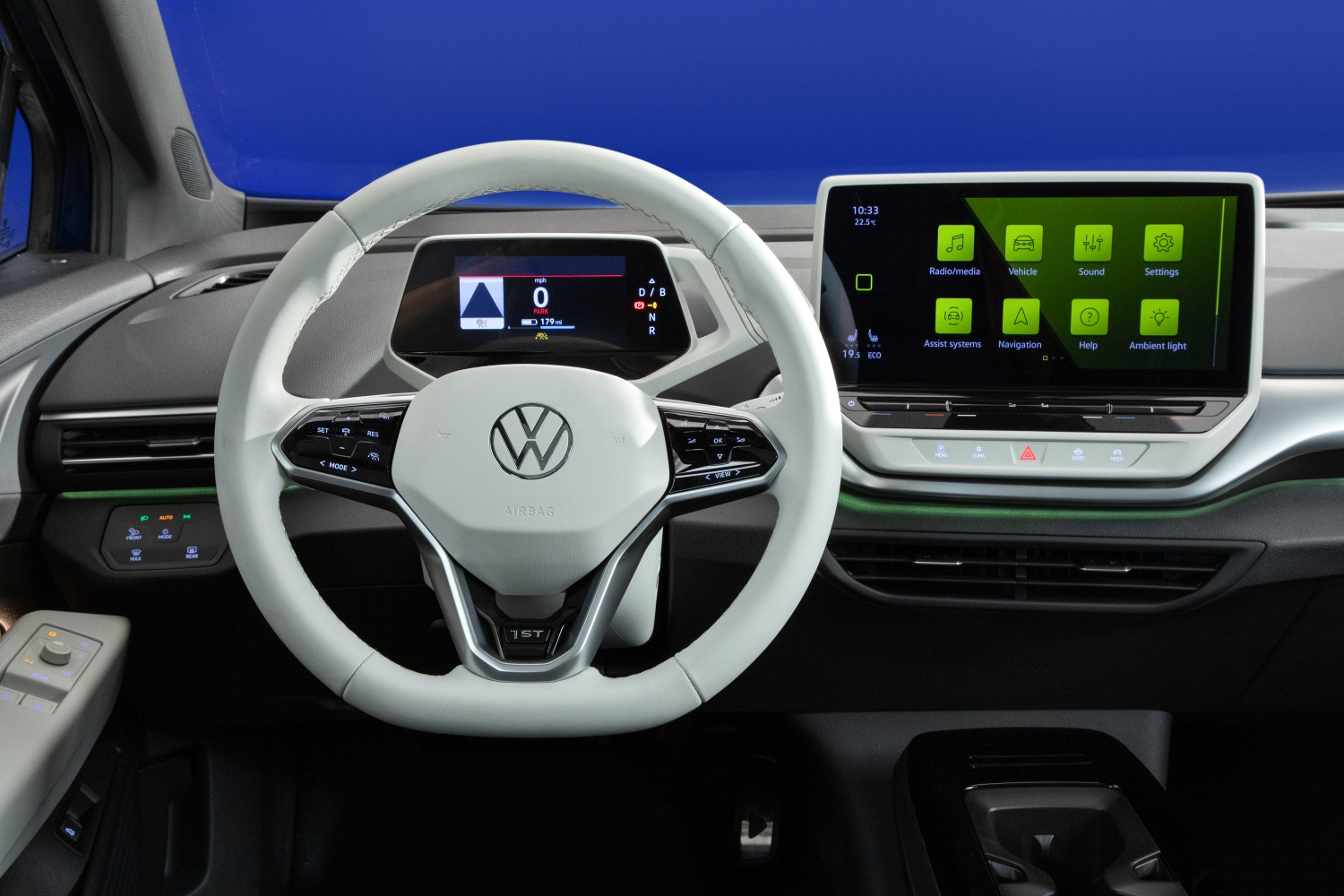
Rather than try to fit a gasoline-shaped peg into an electric-shaped hole, Volkswagen appears to have taken a page from Tesla’s book in its approach to the dash layout and cabin feel in the ID.4.
The interior design of the ID.4 feels like a glimpse of a self-driving future as you could visualize a day when both the steering column and even the infotainment system could simply be deleted. Even the center console, complete with modular cupholders, cubbies and NFC charging pad could eventually be modified to create more passenger space, making the interior of the ID.4. feel even more open and airy than it already does.
The ID.4 launches with three trims: the Pro, Pro S and 1st Edition. The Pro comes with a 10-inch touchscreen. The Pro S and 1st Edition trims come with a 12-inch infotainment touchscreen mounted at the center of the dashboard.
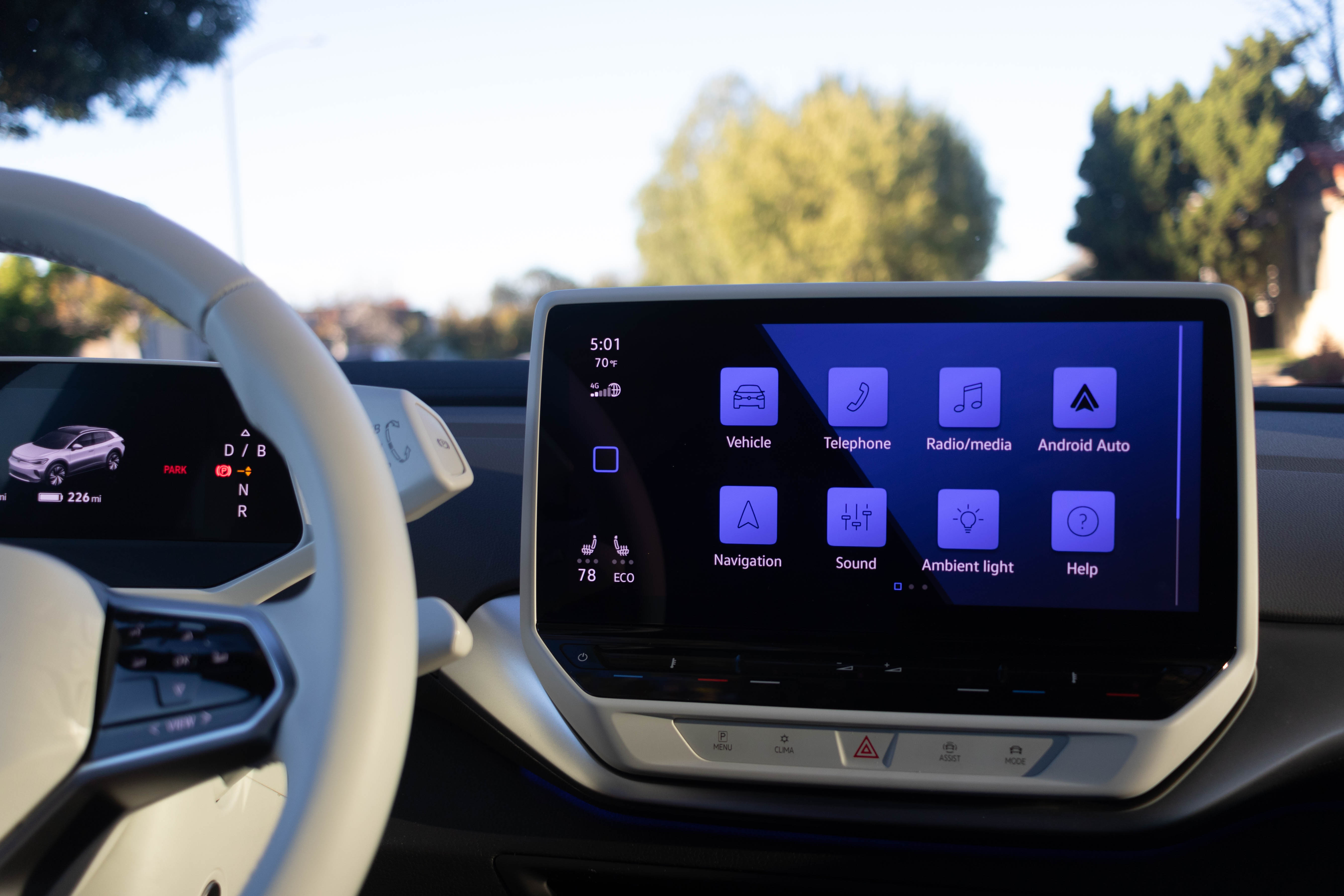
Image Credits: Abigail Basset
As you reach toward the center screen, the icons respond thanks to an in-cabin camera that tracks hand motion toward the system. There are very few hard-touch buttons inside the ID.4, and those that do exist are more like medical-grade haptic buttons used to control everything from climate and audio to the opening and closing of the shade on the optional panoramic fixed-glass roof and even driving modes and driver assistance features. They take a little getting used to, but once familiar they tend to work like slider buttons, allowing you to adjust volume or temperature with slight pressure changes and small slides from left to right.
Instead of buttons, Volkswagen has decided to leverage hands-free voice control in the new ID.4, but during our time with the vehicle, the system felt like it was still in beta.
Both driver and passenger use the touchscreen or specific voice commands to access many of the common features and infotainment of the ID.4. Say “Hello I.D.” and a light strip along the base of the windshield lights up based on which side of the vehicle the voice came from (passenger or driver), indicating that it’s ready to receive the command you say next.
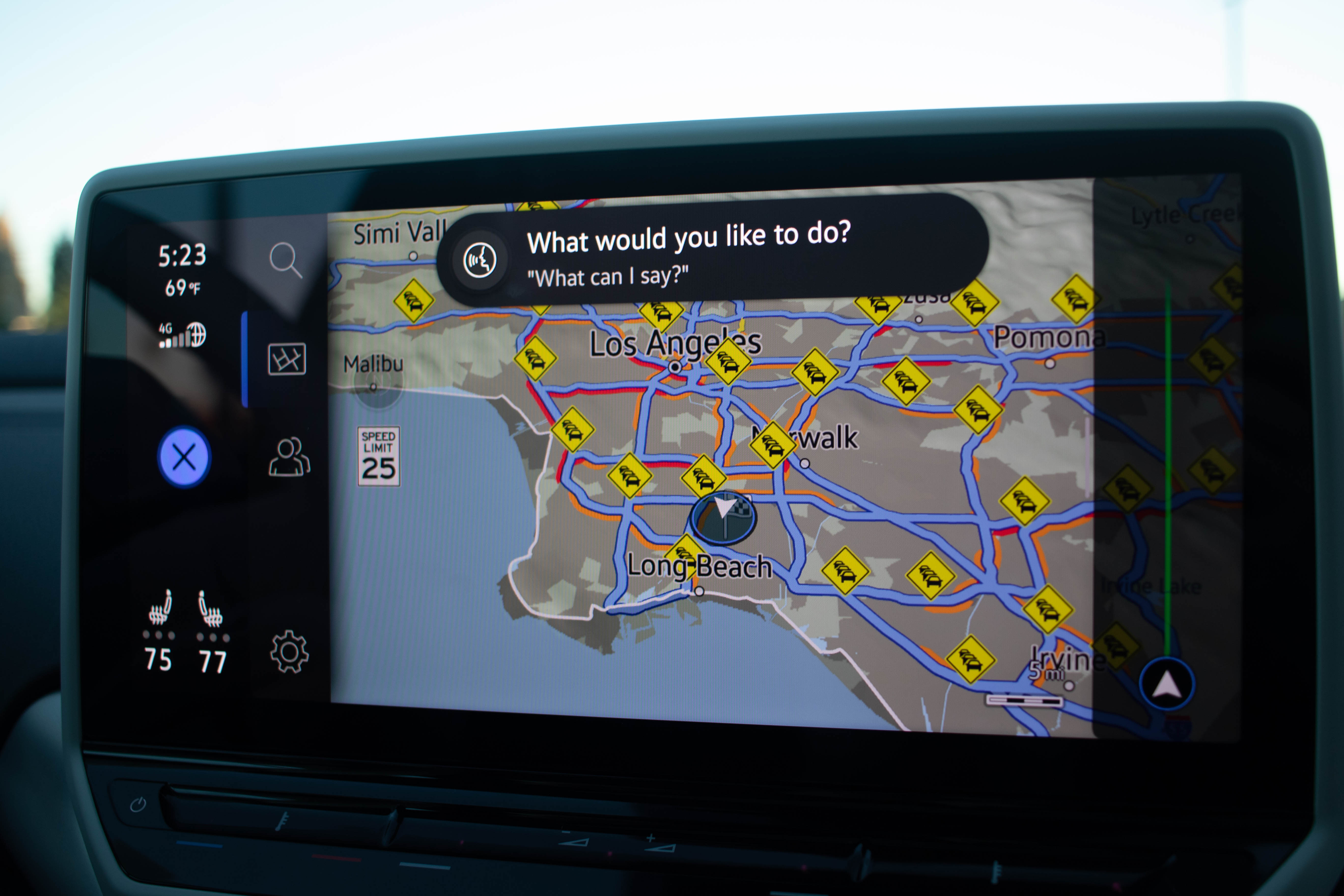
Commands are rather limited at this time and must be initiated by either saying the key phrase (“Hello I.D.”) or pushing the voice control button located on the steering wheel. You can say basic things like navigation commands but you can also say things like “I’m cold,” or “Tell me a joke,” and the ID.4 system will respond by raising the temperature on that side of the car, or telling a seatbelt joke.
During the test drive, the response time from the system was very slow compared to other voice systems on the market, and it struggled to find connectivity to do things like change a Sirius XM channel, (repeatedly saying that it couldn’t find a specific channel number or name) even though my test drive didn’t stray beyond the bounds of Los Angeles and Long Beach. It also failed more often than naught, taking around 10 seconds or more to finally cancel out of the voice control systems when it either couldn’t understand the command or it couldn’t get connectivity.
The navigation system in the ID.4 was also a bit laggy and imprecise, which meant I reverted to using Google maps and the wireless Android Auto system (included along with Apple CarPlay throughout the ID.4 lineup) to get directions. One neat feature of the ID.4’s on-board navigation system, however, is that the light strip along the windshield illuminates on either side of the vehicle as you approach a turn to indicate which direction you should go.
The infotainment screen looks just like your phone or tablet screen: Swipe through the pages of apps or various windows to get to the page you want. Unfortunately, the combination of a laggy connection to the network (despite having three to five bars of 4G connectivity according to the infotainment system), and a laggy load time, the screens would occasionally freeze while swiping between pages, showing half of one page while still loading the next.
As a caveat: I was lucky enough to get three separate opportunities to spend extended time in different ID.4s in the Los Angeles press fleet and only experienced the lag/freeze with one of the vehicles. Volkswagen PR says that the software in the test vehicles is not the final version that customers will receive and it will be updated before getting to owners, which should solve for the strange stuttering and voice command issues that I experienced.
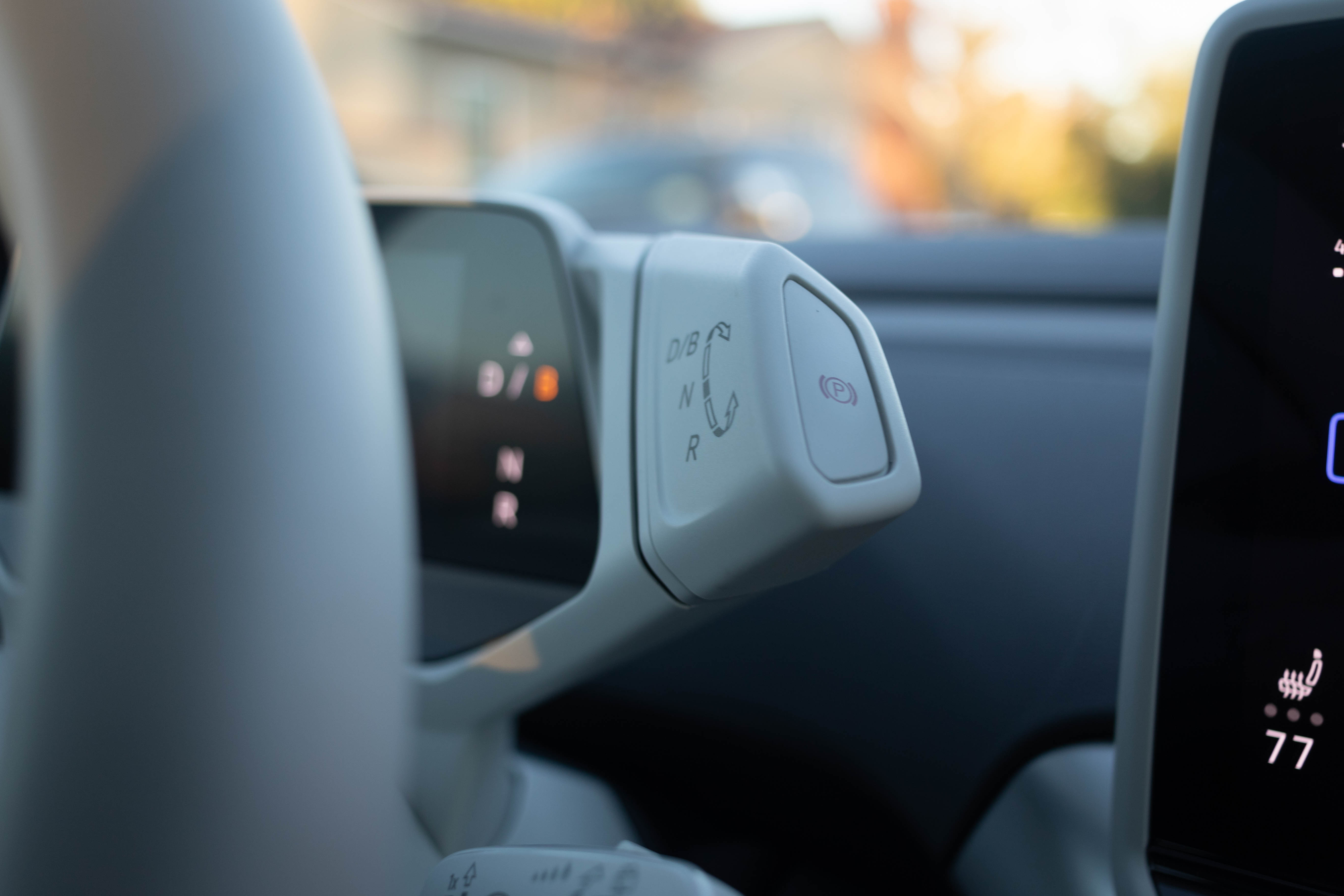
The ID.4 will also get Alexa capability later this year through their Car-Net service, which includes an app that can help you monitor your vehicle from afar. The app is simple enough to use: Owners log in and can see the location, charge level and status of their ID.4.
VW made a multitude of interesting design choices inside the ID.4 including the placement of the main instrument panel and the transmission selector. Rather than attaching these items to the dash or center console like you’d find in a typical vehicle, they’re attached directly to the steering column. When you move the steering wheel, the instrument panel and transmission rocker move with it. Volkswagen uses a 5.3-inch screen attached to the steering wheel to provide information about everything from speed and direction of travel to range, trip and basic navigation information. You use a rhombus-shaped rocker at the right side of the steering wheel to toggle through driving modes rather than a standard button or shift lever.
There’s a start/stop button located in a rather hidden spot on the right side of the column to start the ID.4, but it’s largely superfluous. When you unlock the vehicle and sit in the driver’s seat, the ID.4 powers on and is ready to drive. When you unlatch your seatbelt and climb out, the ID.4 powers down. That makes things a bit complicated if you have friends or family in the vehicle while you dash into a place to run an errand, but the ID.4 allows passengers to keep things like the AC and heat going for a short period of time by using controls that appear on the infotainment screen, even if the driver isn’t in the vehicle.
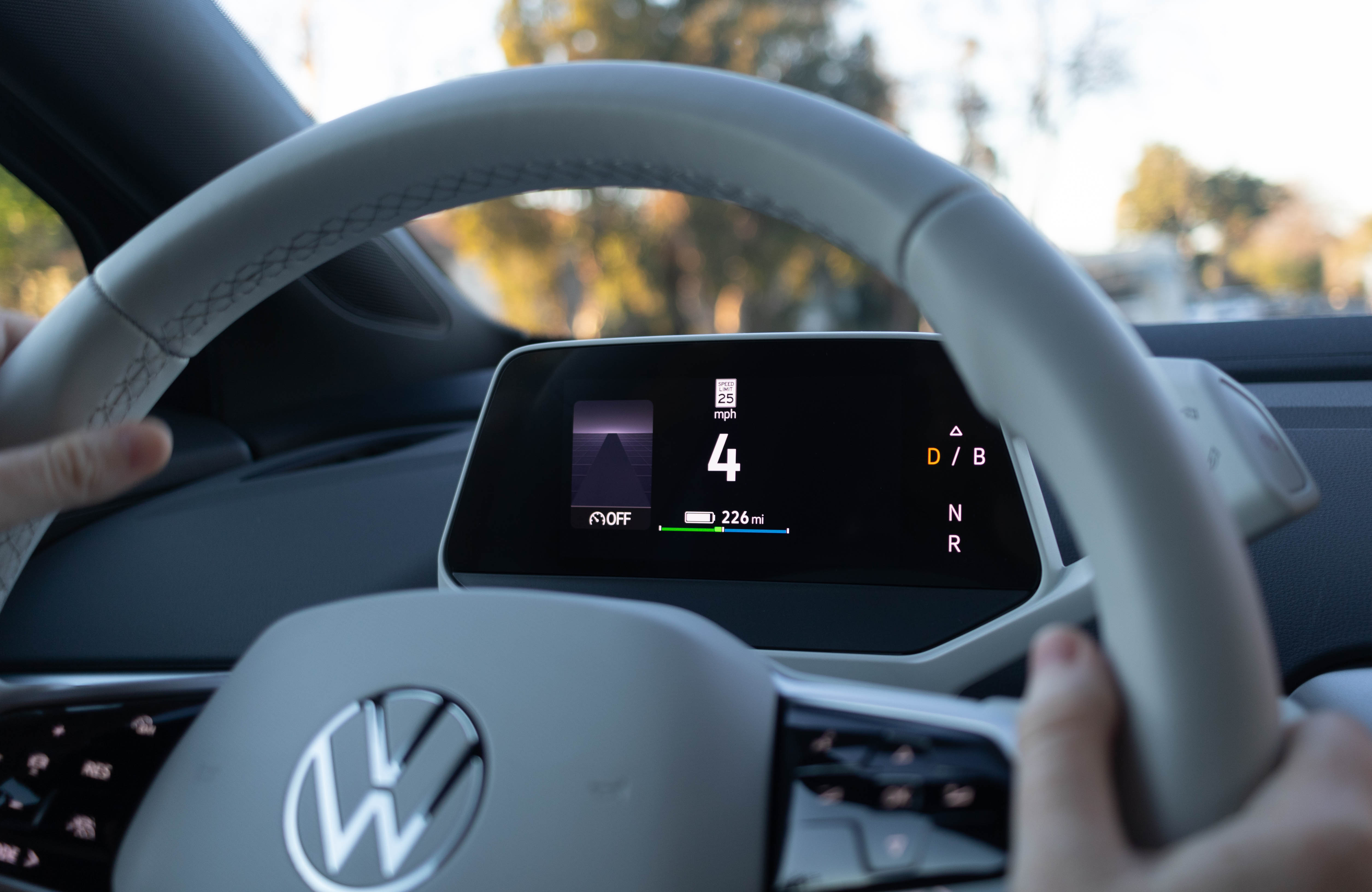
Converting drivers to EVs
Volkswagen says that its research has shown that roughly 30% of crossover owners would consider an electric crossover. There’s no denying that the ID.4 enters a crowded crossover market complete with extremely popular gasoline and hybrid competitors like the Toyota RAV4 and Honda CR-V. Volkswagen says that, based on its research, consumers shouldn’t feel any range anxiety since most crossover owners drive around 60 miles per day and the battery system offers an EPA-estimated 250 miles of range. You can charge the ID.4 from 5% to 80% in 38 minutes at 125 kW.
A full charge at home is estimated to take around 7.5 hours but, if you’re out and about, Volkswagen is offering free, unlimited charging at DC fast chargers by Electrify America at no additional cost for the first three years of ID.4 ownership, which sounds great, but comes with some caveats. VW says that it expects most people to charge overnight on typical residential power, and it’s clear that the company doesn’t expect owners to use public chargers all that frequently because the process of locating an available charger is not seamless, at least not at the ID.4’s launch.
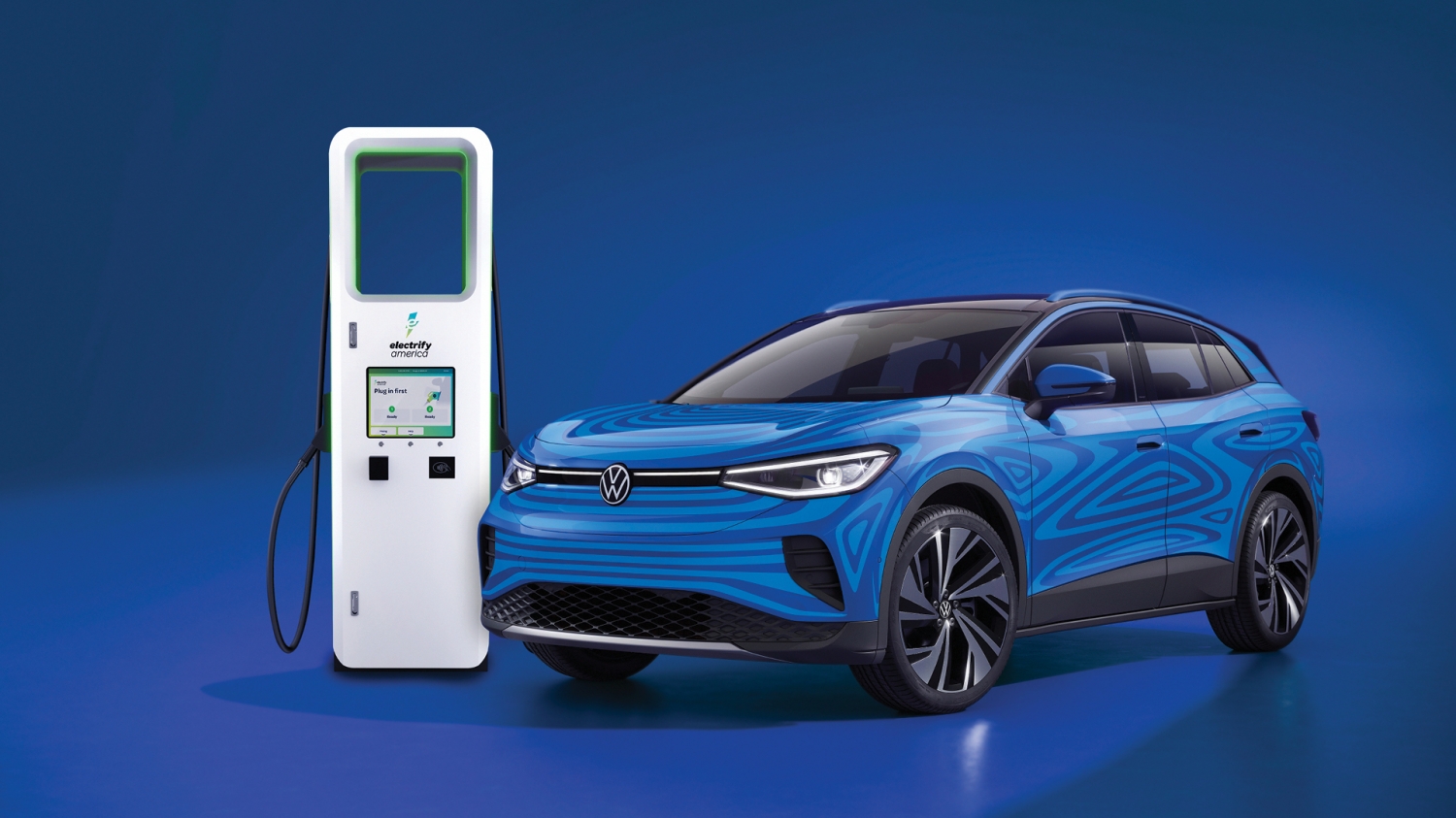
Electrify America is a subsidiary of VW, yet they operate completely separately from Volkswagen. The company operates 550 charging stations and more than 2,400 DC fast chargers across the country. You can search for “charging stations,” through the on-board nav but the system brings up all charging stations in the vicinity and doesn’t show which are online and available. In order to find specific online and available Electrify America chargers, owners have to pull out their phones and open the Electrify America app. You can then send the location of a specific charger to Android Auto or Apple CarPlay to navigate. Unfortunately, at this point, the Electrify America app does not show up in Android Auto.
This process is rather clunky and would require owners to pull over and park to safely complete before heading to the charging station — at least at this point in time. Volkswagen says that an over-the-air update coming later this year will further integrate Electrify America stations into the on-board nav in a more seamless way.
The good news is that the EPA-estimated fuel economy equivalent for the Pro S and 1st Edition models is 104 MPGe for city driving, while highway driving is rated at 89 MPGe, for a combined city/highway rating of 97 MPGe.
One of the striking features of the ID.4 is how it drives. Transmission modes on the ID.4 include a B or brake mode — a common and exceedingly convenient setting that allows for one-pedal driving on electric vehicles. Take your foot off the brake and the ID.4 slows slightly, regenerating electricity and sending it back into the battery. It’s a great feature in stop-and-go traffic and Volkswagen intentionally tuned the one-pedal driving to be less aggressive than those in other electric vehicles, with the aim of making the feel more familiar for first-time electric vehicle owners.
On the road, the ID.4 feels well planted and not nearly as large as it looks. It’s nimble but not exactly quick off the line (VW has not released 0-60 mph times) though it doesn’t leave you sweating to make a short merge. It’s certainly no tire smoker or rocket ship, however.
Since it’s a rather bulbous shape, there is some very minor wind noise at speed on the road, but the ride is comfortable and confident. At speeds below 20 miles an hour (and when you put it into reverse), it does make that characteristic electric car sound to alert pedestrians. It’s not noticeable inside the cabin when the windows are raised, but pass a neighbor who is working on a car in their garage, and you’ll be sure to arrive home to a text asking if that was you driving around in the car that sounds like a spaceship.
ADAS form and function
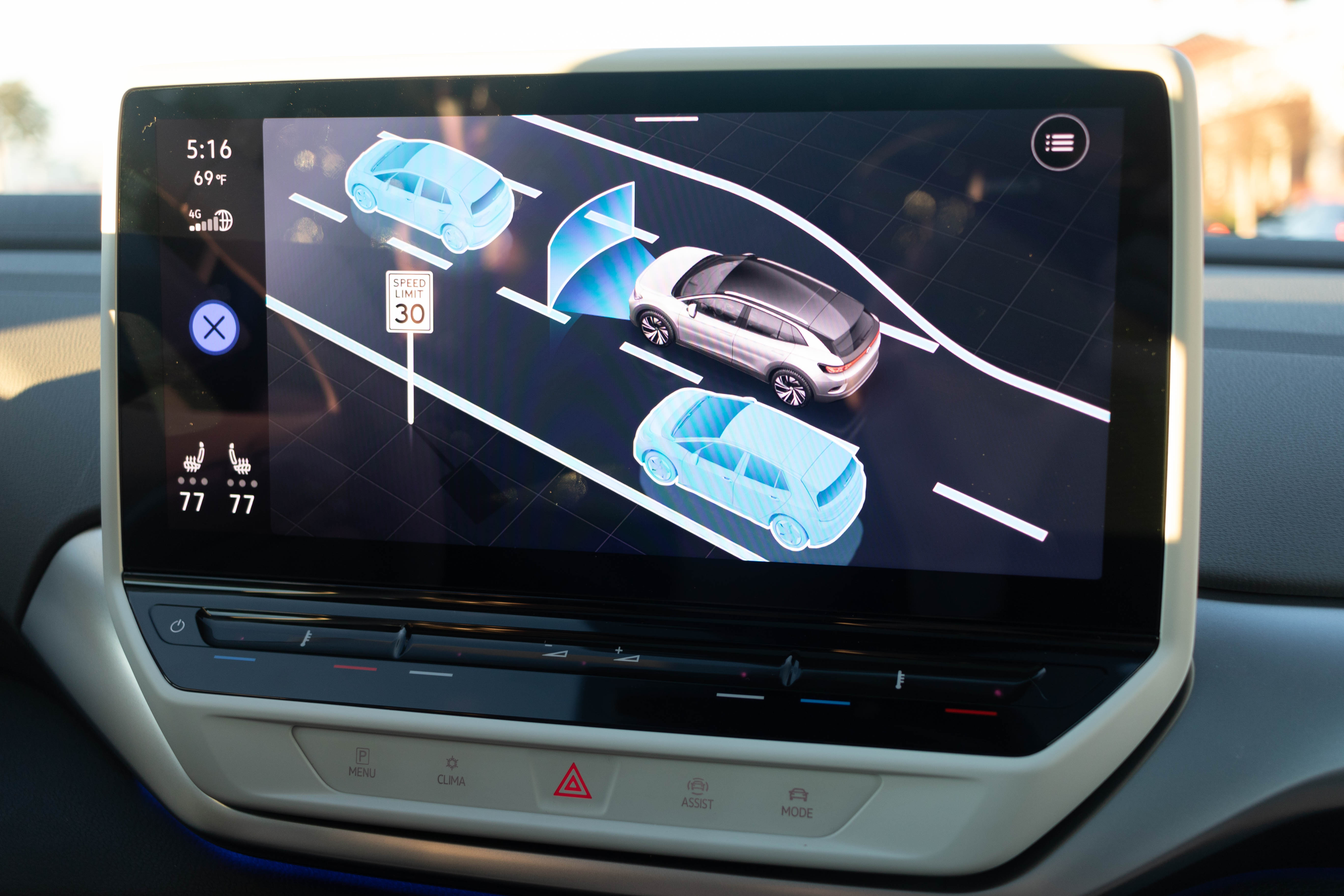
VW’s Travel Assist is the branded name for the company’s Level 2 autonomous driving system, which works at speeds that range from 0-95 mph. Travel Assist uses both the adaptive cruise control and the lane-keeping systems to follow the road and other vehicles ahead. When a motorcycle suddenly hops into your lane, the instrument screen shows an image of a motorcycle directly in front of the vehicle. If said motorcycle decides to randomly slam on the brakes, the ID.4 responds and brakes automatically. If traffic comes to a stop ahead, the ID.4 Travel Assist waits until traffic moves again. It approximates a human response to traffic motion very well — neither waiting inordinately long and leaving huge gaps (which causes rubber banding in traffic) nor accelerating aggressively.
The system makes long stints in heinous traffic bearable. I spent an hour commuting on the dreaded 405 freeway in Los Angeles during rush hour and only had to keep my hands lightly on the capacitive steering wheel to keep the system engaged.
The skateboard powertrain
The VW ID.4 is built on a new skateboard architecture called MEB, or modular electric drive matrix, with an AC permanent-magnet synchronous motor that makes 201 horsepower and 229 foot-pounds of torque mounted at the back of the vehicle, above the rear axle — much like the old Beetle. At launch, VW is only offering a rear-wheel-drive version, but an all-wheel-drive version will be available by the end of the year, offering 302 horsepower.
Volkswagen is purchasing batteries from Panasonic for the ID.4 and assembling the 82-kWh, 12-module, 288-pouch-cell battery packs themselves at plants in China and Germany. There are plans to begin production in the U.S. soon. Volkswagen also builds its own electric motors.
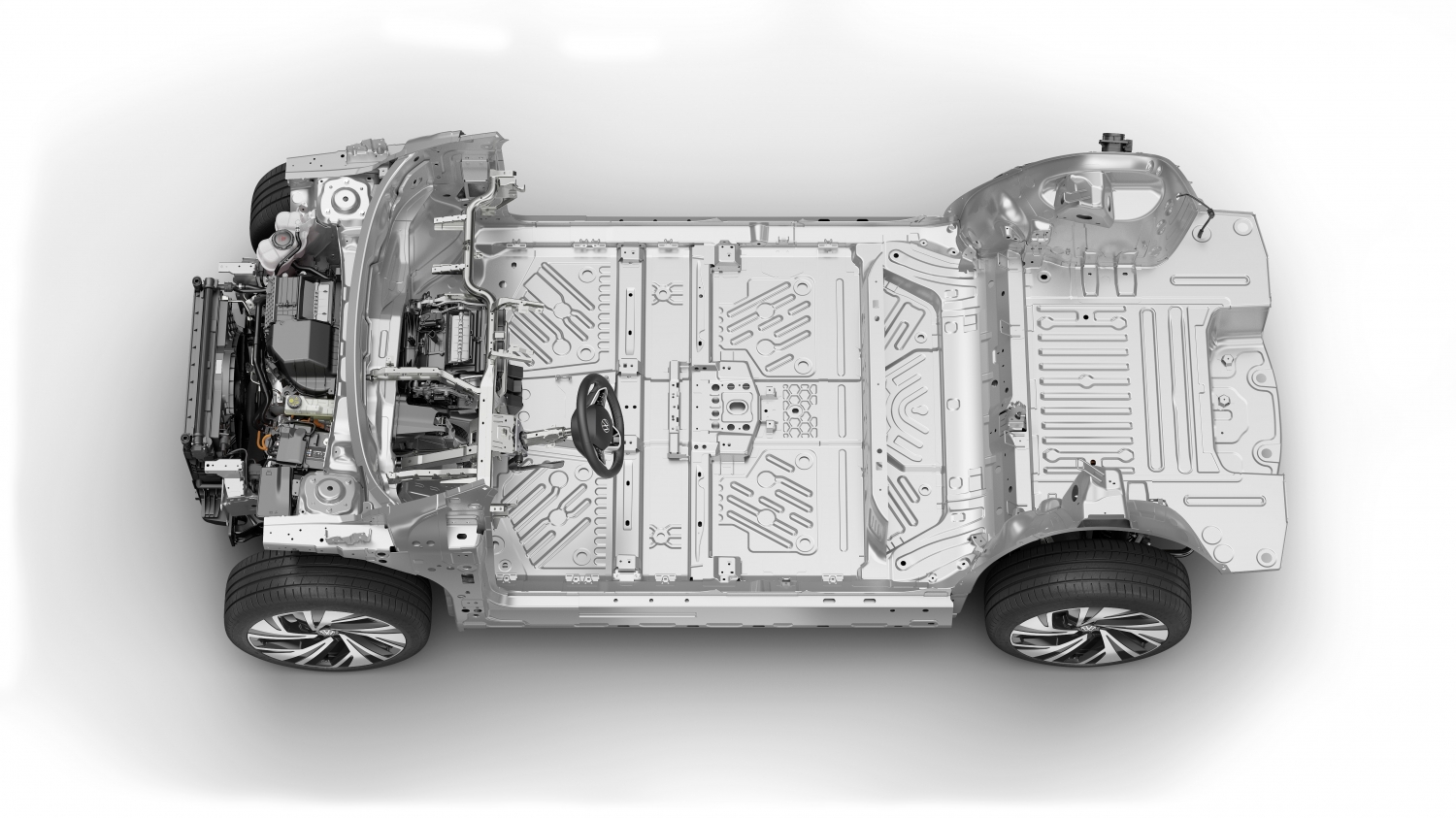
Image Credits: Volkswagon
All in, the VW ID.4 makes electric vehicles more attainable for the crossover buying public who can’t afford the high price tags for the other luxury all-electric crossovers like a Jaguar I-Pace, Tesla Model Y, Polestar or Audi e-tron.
Yet it also competes well with popular gasoline-powered crossovers like the Honda CR-V and the Toyota RAV4, especially when you add in the potential for as much as $7,500 in rebates. Where the VW ID.4 truly stands out is in its blending of advanced technology and affordability in a good-looking EV that won’t give you range anxiety. Will it be the “car for the millions?” We’ll have to wait and find out.
Can solid state batteries power up for the next generation of EVs?
Early Stage is the premier ‘how-to’ event for startup entrepreneurs and investors. You’ll hear first-hand how some of the most successful founders and VCs build their businesses, raise money and manage their portfolios. We’ll cover every aspect of company-building: Fundraising, recruiting, sales, product market fit, PR, marketing and brand building. Each session also has audience participation built-in – there’s ample time included for audience questions and discussion. Use code “TCARTICLE at checkout to get 20 percent off tickets right here .
- Models / ID.4
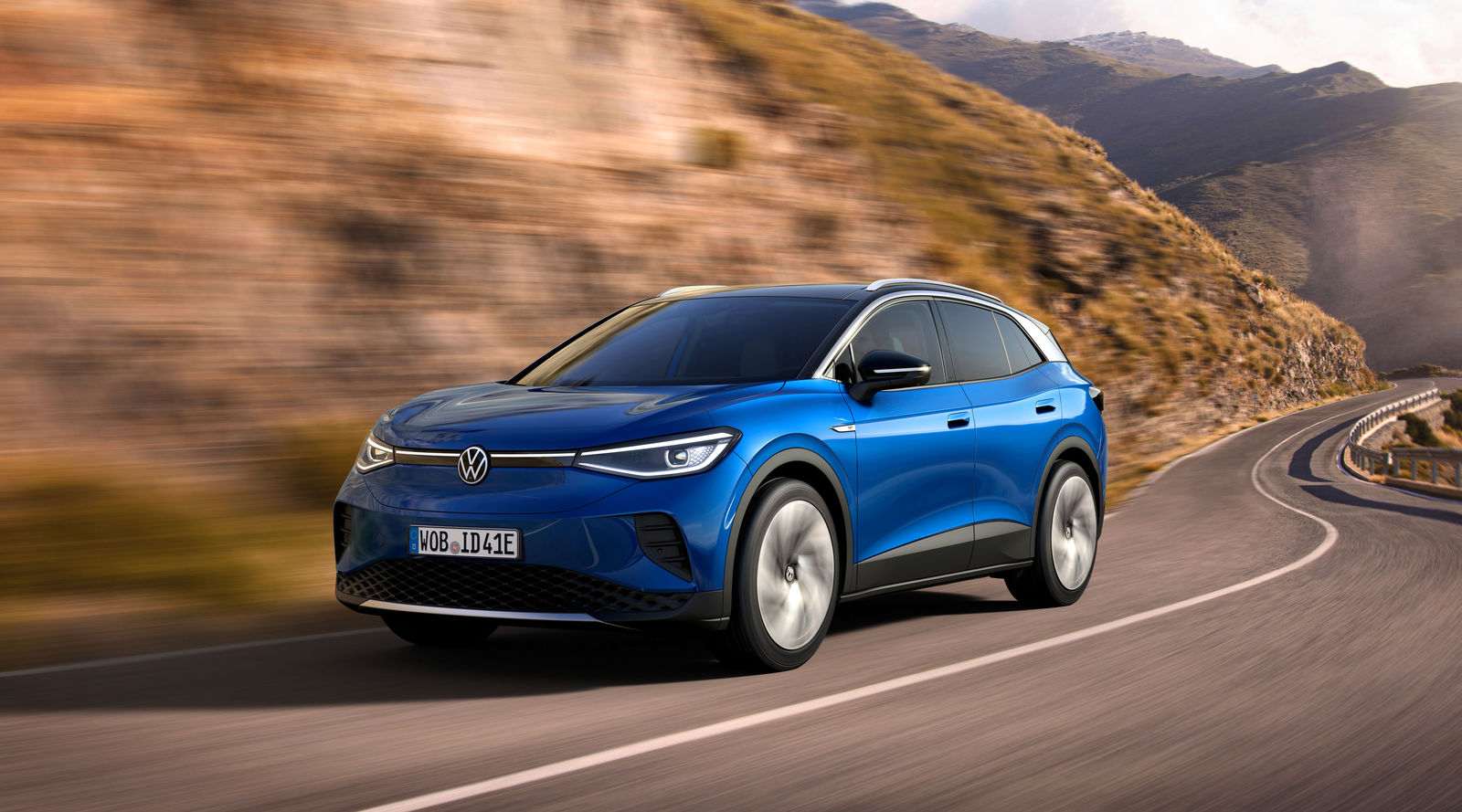
The new Volkswagen ID.4 – World premiere of the fully electrically driven SUV
- ID.4 launches into the world’s largest market segment, the compact SUV class
- Electric motor with 150 kW (204 PS), achieving a range of up to 520 km
- Powerful design, large vehicle interior, pioneering operating concept
Presenting the ID.4, which is celebrating its digital world premiere. This is Volkswagen’s first fully electrically driven SUV generating zero local emissions and is produced with a carbon-neutral balance. It will be launching into the world’s largest market segment, the compact SUV class.
“The ID.4 is an emotional all-rounder which will impress many customers with its efficient electric drive, generous amount of space, modern assist systems and powerful design,” says Ralf Brandstätter, Chief Executive Officer of Volkswagen brand. “As the first global electric car, this model will roll out our modular electric drive matrix platform that has been developed specifically for electric mobility the world over. Volkswagen is thus once again demonstrating its leading role in innovation, technology and quality on the high-volume market.”
SUVs are very popular with an increasing number of customers. They are the most popular vehicle segment in the USA and China as they offer good levels of visibility, safety and comfort. In Europe and Germany market shares are also continuously on the up and especially compact models are booming. With the ID.4, Volkswagen is offering a fully electrically driven SUV for the very first time. It offers the space, flexibility and all benefits customers appreciate about SUVs.
The ID.4 is an all-round talent that can be driven in a sporty, yet also easy and comfortable way. The battery stores up to 77 kWh of energy (net) and enables ranges of up to 520 km (WLTP). It is installed below the passenger compartment which guarantees a low centre of gravity. The electric drive motor, positioned at the rear axle, generates 150 kW (204 PS) – enough to accelerate from 0 to 100 km/h in 8.5 seconds and deliver a top speed of 160 km/h. Thanks to the rear-wheel drive’s strong grip and its 21 centimetres of ground clearance, the E-SUV also performs well in gentle off-road terrain.
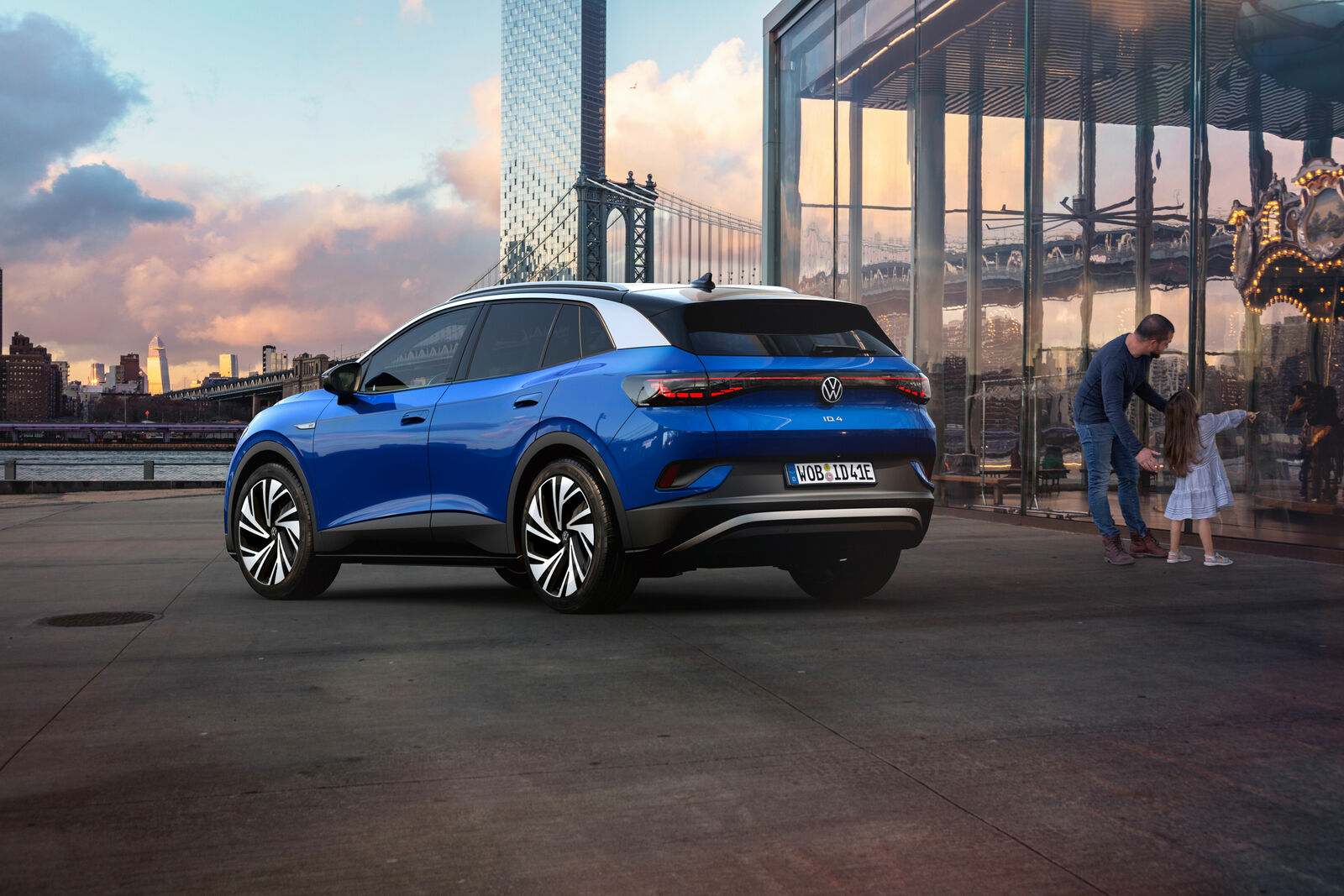
Dynamic appearance. The ID.4’s exterior has athletic proportions for an ultra-modern appearance. Its clear, flowing design is inspired by nature and guarantees very good aerodynamics with a drag coefficient of 0.28.Its basic version already features headlights that are almost completely equipped with light-emitting diodes while its tail light clusters have been fully equipped with this technology. As the top-of-the-range version, interactive IQ.Light LED matrix headlights are even more progressive: they welcome drivers with swivelling lens modules and generate an intelligently controlled main beam. These headlights have been paired with the new 3D LED tail light clusters. Their tail light is particularly homogeneous and lights up in an intensive red. The large wheels with a diameter of up to 21 inches underline the vehicle’s character.
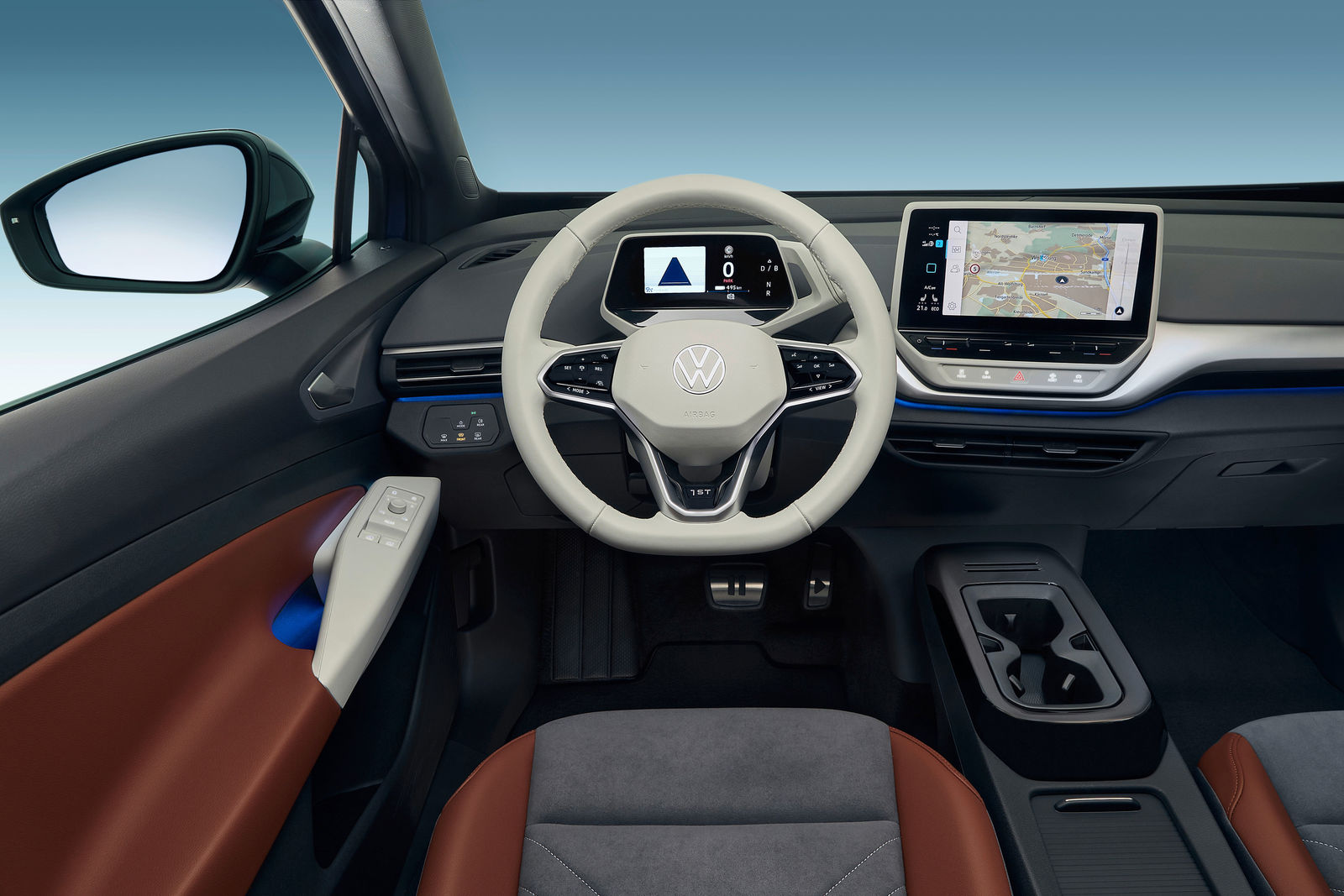
Spacious concept: long wheelbase, plenty of room for passengers and luggage The ID.4 with a length of 4.58 metres uses Volkswagen’s modular electric drive matrix (MEB) architecture. It divides the space for occupants and technology in a completely new way in favour of passengers. The room available in the vehicle interior is at the level of conventional SUVs in the next category up. Colours and materials are contemporary while also being homely. Depending on the rear seat backrest’s position, the luggage compartment boasts a capacity from 543 to 1,575 litres. The equipment range of the ID.4 includes an electrically driven boot lid, roof railing and a towing bracket.
The E-SUV’s operating concept does not depend on physical buttons and switches. It is based on two displays – one of which diagonally measures up to 12 inches and features touch functionality – as well as “Hello ID.” natural voice control. The new ID.Light – a narrow light strip under the windscreen – intuitively supports drivers. An augmented reality head-up display is optionally available to blend a host of displays with reality – for instance, navigation arrows telling drivers to turn off are projected onto the road surface in exactly the right lane. The Discover Pro navigation system brings We Connect Start online services on board. IQ.Drive assist systems make driving an even more relaxed experience and this particularly applies to Travel Assist. Software and hardware in the ID.4 have been designed as part of a completely new architecture, making it possible for customers to download updates to the car after the purchase.
We Charge: charge at home, when out and about and on long journeys Together with the ID. models, Volkswagen is launching on the market a complete package for convenient, connected and sustainable charging of electric cars under the name We Charge. This offers the ideal solution for any situation – whether you are at home, out and about or on a long journey. The ID.4 can be recharged with direct current to cover the next 320 km (as per WLTP, at 125 kW) at a DC quick-charging station in around 30 minutes.
In parallel, Volkswagen is establishing an ecosystem of sustainable electric mobility surrounding ID. models. ID.4 customers will receive a vehicle that has been produced with a carbon-neutral balance. And if it is charged using sustainably produced electricity – like Volkswagen Naturstrom – it will remain carbon-neutral on the road too.
Volkswagen’s strategy: the future of mobility is electric As of late, Volkswagen has been supplementing the brand’s traditional product portfolio with the ID. family: a new, independent product range. Following the compact ID.3 , the ID.4 SUV is the second fully electric model. In the future, Volkswagen will be competing in the globally booming compact SUV segment with the ID.4. The ID.4 will be gradually turned into an electrically driven, global car with plans to produce and sell the E-SUV not only in Europe, but also in China and later in the USA. On a whole, Volkswagen brand will be investing eleven billion euros in electric mobility by 2024 as part of the Transform 2025+ strategy.
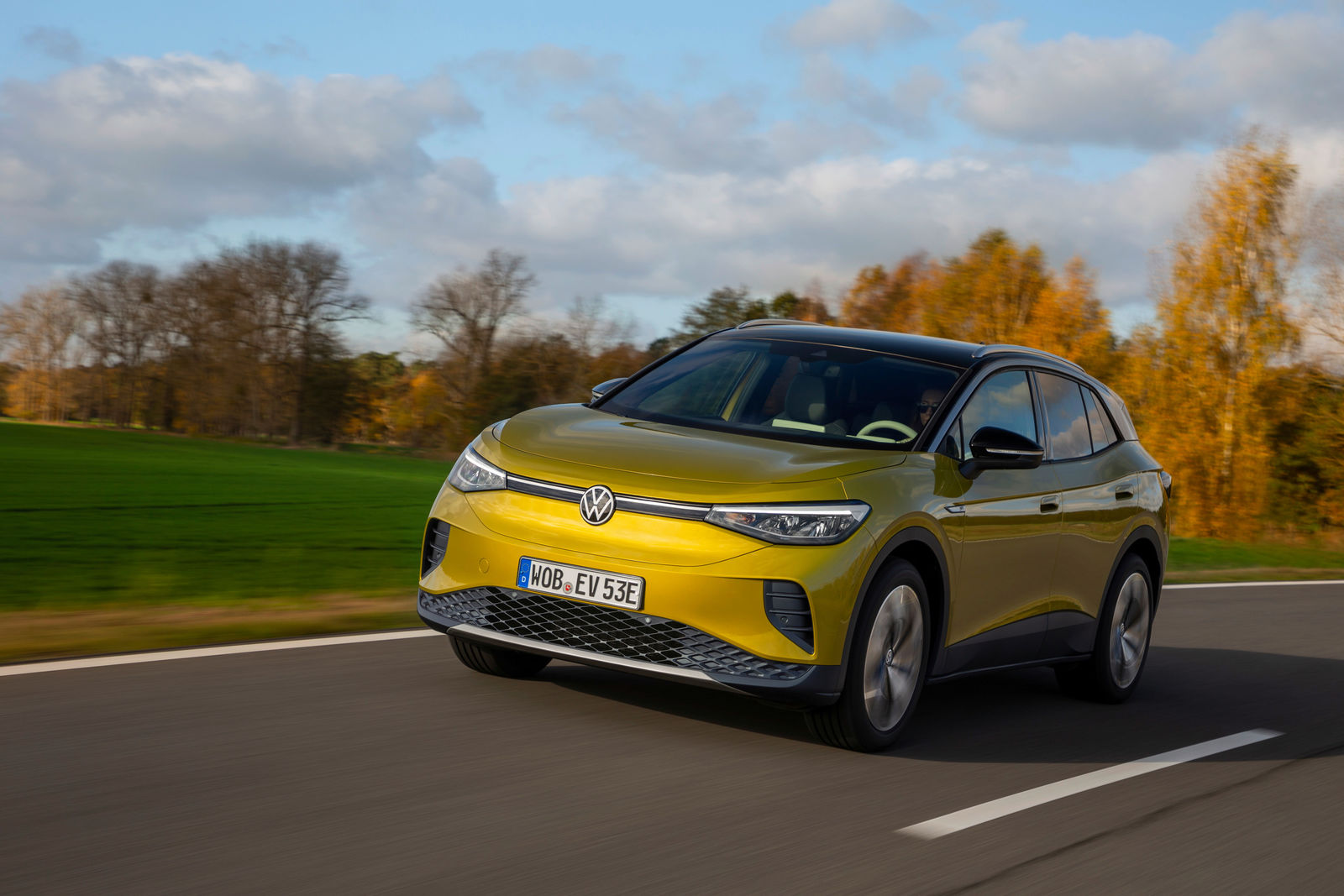
Media contacts

- Terms of Service
- Cookie Policy
- Third Party Licence Notes
- Volkswagen AG
- Cookie Settings
- Press Releases
- Basic Infos
- Media Documents
- Media Contacts
The Volkswagen Newsroom is an open platform and offers comprehensive search options to all users.
If you would like to be kept informed about our press releases you can also subscribe to our media information newsletter.
The specified fuel consumption and emission data are determined in accordance with the measurement procedures prescribed by law. 1 January 2022, the WLTP test cycle completely replaced the NEDC test cycle and therefore no NEDC values are available for new type approved vehicles after that date.
This information does not refer to a single vehicle and is not part of the offer but is only intended for comparison between different types of vehicles. Additional equipment and accessories (additional components, tyre formats, etc.) can alter relevant vehicle parameters such as weight, rolling resistance and aerodynamics, affecting the vehicle's fuel consumption, power consumption, CO 2 emissions and driving performance values in addition to weather and traffic conditions and individual driving behavior.
Due to more realistic testing conditions, fuel consumption and CO 2 emissions measured according to WLTP will in many cases be higher than the values measured according to NEDC. As a result, the taxation of vehicles may change accordingly as of 1 September 2018. For further information on the differences between WLTP and NEDC, please visit www.volkswagen.de/wltp .
Further information on official fuel consumption data and official specific CO 2 emissions for new passenger cars can be found in the "Guide to fuel economy, CO 2 emissions and power consumption for new passenger car models", which is available free of charge from all sales dealerships and from DAT Deutsche Automobil Treuhand GmbH, Hellmuth-Hirth-Str. 1, D-73760 Ostfildern, Germany and at www.dat.de/co2 .
6 driving situations where IQ.DRIVE can lend a hand
March 22, 2022
No matter how focused you are when behind the wheel, or how careful you are in everyday driving , things happen—like a sudden obstacle or a vehicle you can’t see in your mirrors. And no matter how comfortable it is inside your vehicle , that highway commute can be a little stressful.
To help you better manage these situations , Volkswagen has developed advanced driver - assistance technology called IQ.DRIVE. 1 Available on most 2022 Volkswagen vehicles and standard on the 2022 Volkswagen Arteon and ID.4 EV, IQ.DRIVE offers innovative features designed for convenience and peace of mind.
The system can alert you to obstacles in front, and helps keep an eye around you. On select models , it even includes hands-on semi-autonomous capability for a more comfortable driving experience .
Here are six real-world situations you might encounter when driving , and how IQ.DRIVE can give you added confidence.
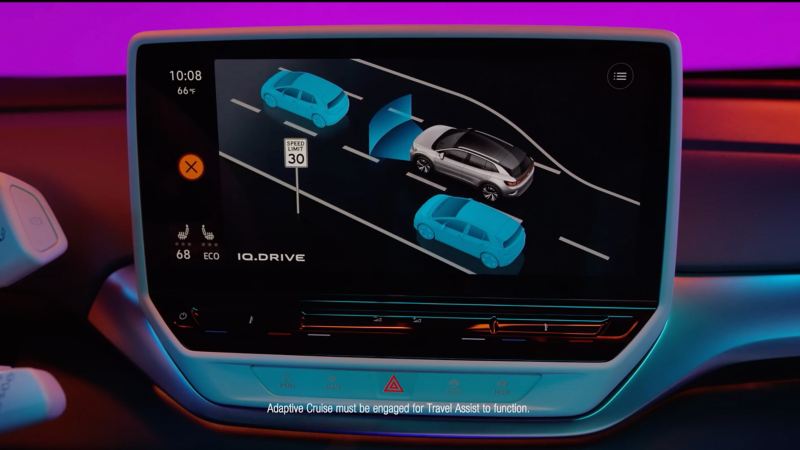
If you’d like reduced stress during your commute.
Maintaining focus and concentration over a long highway trip can lead to a surprising amount of fatigue. IQ.DRIVE includes technology designed to help make highway driving more comfortable. With your hands on the steering wheel, activate Travel Assist, 1 a semi-autonomous driver - assistance system that uses a camera and sensors to keep your vehicle centered in its lane, and helps maintain a preset distance from the vehicle ahead. Note that Travel Assist will work only if the system senses both of your hands on the wheel.

If your vehicle starts to drift into another lane.
Not using Travel Assist? IQ.DRIVE has you covered, and will intervene if it detects an unintentional lane change while traveling above 37 mph. Within the system limits, IQ.DRIVE is capable of keeping you in your lane as long as there are clear lane markings present.
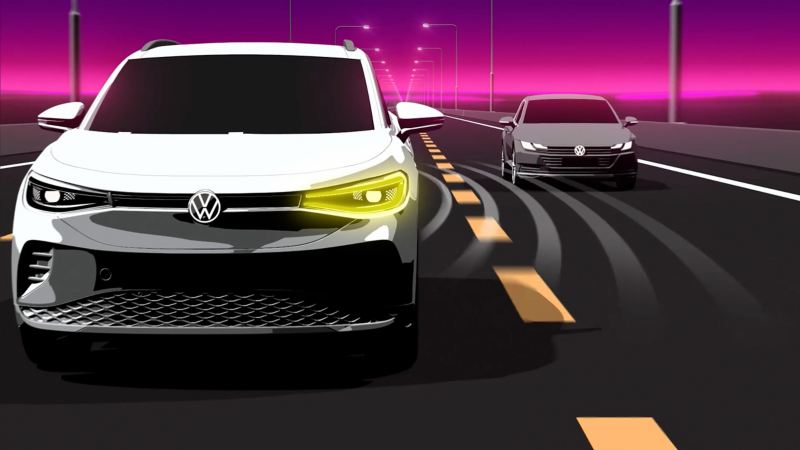
If there’s a vehicle in your blind spot.
Every vehicle has a blind spot—a point at which you might not be able to see a vehicle riding near yours in an adjacent lane. Should you attempt to make a lane change while a vehicle is in your blind spot, IQ.DRIVE can alert you. Within the limits of the system, it can also counter-steer to help avoid trouble if you continue to attempt a lane change after being alerted.

If there’s potential danger of collision with the vehicle ahead.
IQ.DRIVE helps monitor traffic and can alert you to a potential rear-end collision with the vehicle in front of yours. If you don’t fully react to the alert, the system can increase brake pressure or automatically apply the brakes. Within system limits, IQ.DRIVE can also warn you if there’s a pedestrian crossing in front of your vehicle and will, in certain circumstances, brake automatically if you don’t respond to the warning.

If you’re backing up and there’s a vehicle crossing behind yours.
Say you’re backing out of a narrow driveway onto a busy street, and obstacles like walls or parked cars are preventing you from getting a clear view of street traffic. While you’re in reverse, IQ.DRIVE engages sensors that can alert you to vehicles crossing behind yours, and can even help brake if needed.
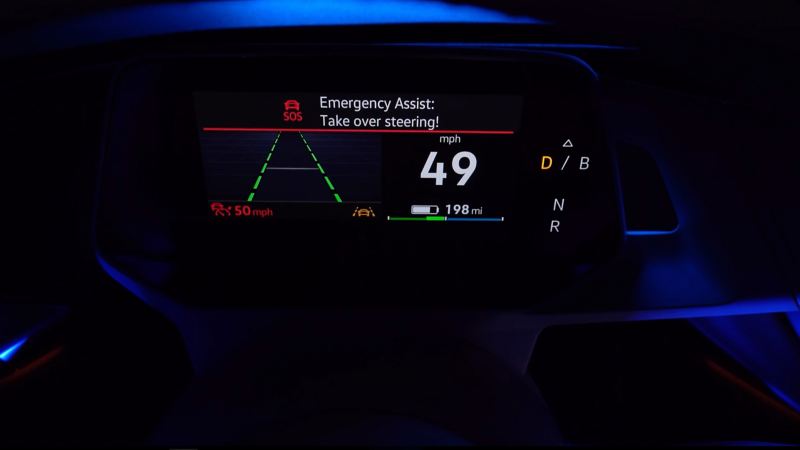
If you’re at the wheel and become unable to drive.
IQ.DRIVE monitors steering wheel activity and can deliver a series of alerts if it detects that your hands are not on the wheel and you are not actively operating the vehicle . If you don’t respond to these alerts, the system can bring the vehicle to a controlled stop. 2
Related Articles
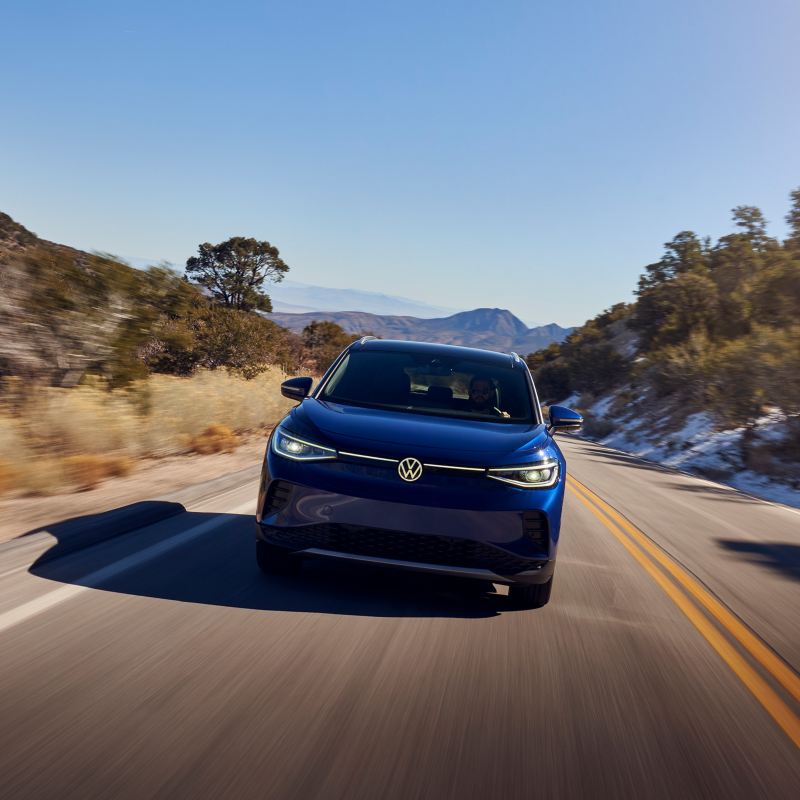
Ten surprisingly smart features on the Volkswagen ID.4 SUV
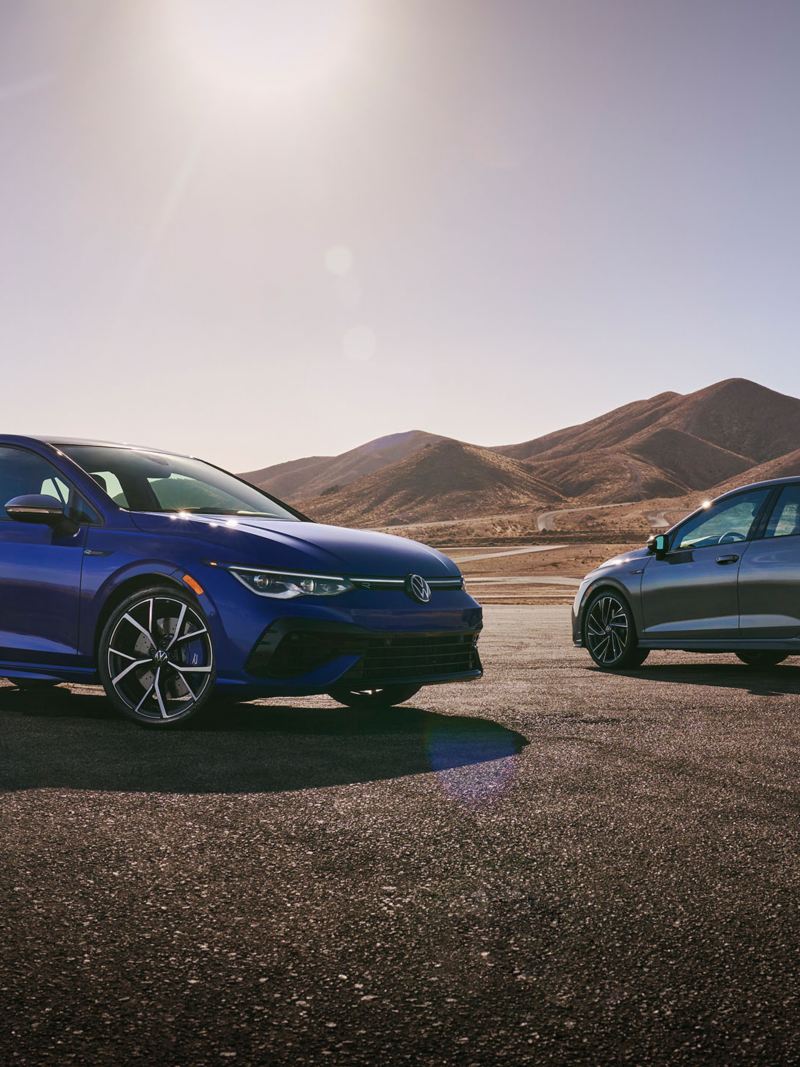
Keeping driving fun alive in the 2022 Volkswagen Golf GTI and Golf R
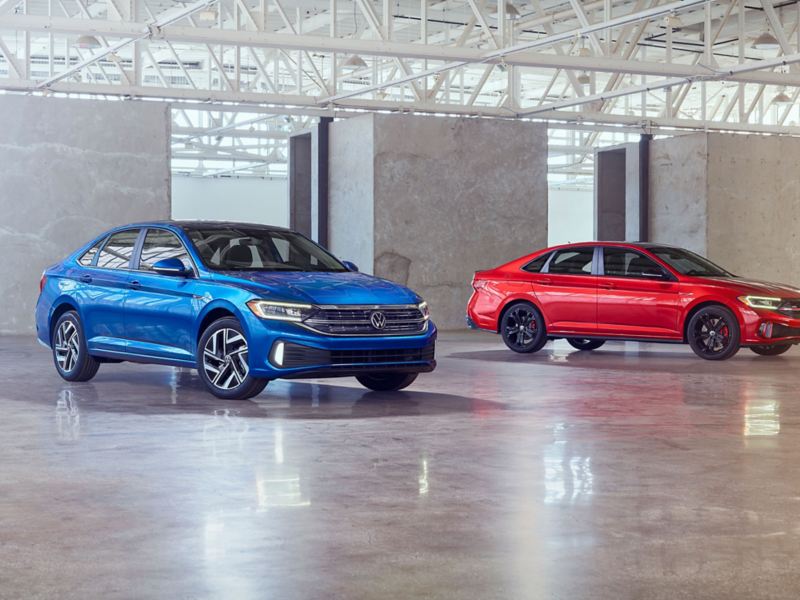
Updating the 2022 Jetta and Jetta GLI
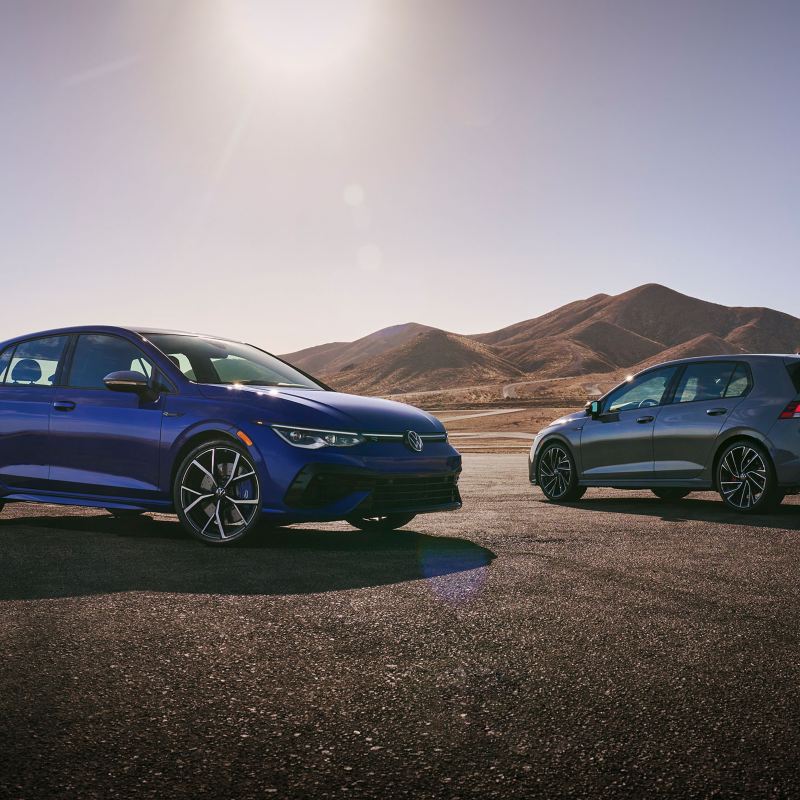

- Forum Listing
- Marketplace
- Advanced Search
- Volkswagen ID Series Model Specific Forum
- Volkswagen ID.4
ID.4 Travel Assist / Lane Assist
- Add Yours: VW ID. Buzz Owner's Registry
Kitt said: It's also an option in the menu. Click to expand...
Bubbajet said: Didn't Tesla change what the steering wheel buttons/rollers do on the Model 3/Y a couple of years ago? Labels go a long way. I love the idea of soft buttons that can be reconfigured, but they need labels too. I'm mildly jealous of your Tesla. That's what I'd have if they'd shipped the Model 3 just a few months earlier. Click to expand...
TT97 said: Have you tried left & right on the right scroll button? Click to expand...
TT97 said: I didn't want to overcomplicate things Click to expand...
Bubbajet said: krusshall is correct. Just gotta learn how to use it. Click to expand...
Kitt said: We disagree here. VW has a long history and it shows here. I assume it went like this: They added a cruise control button to the steering wheel when it came it out. When ACC came out, they just added a second button not to confuse existing VW drivers who were used to cruise control. But ACC has variable distance option, so they added a button next to the ACC button to set distance, presumably because the first car with ACC didn't have an infotainment system. (a distance button is super odd, because it's a preference or setting you should set once and not need to change while driving). Then PCC came along, and TravelAssist. And those needed buttons too. And that's why we ended up in 2021 with half a dozen buttons on the left side of the steering wheel for what basically should be one feature. Don't get me wrong, it's not a deal breaker for me, but as an industrial designer and software engineer, bad design definitely annoys me. Click to expand...
krusshall said: No menu option that I can find. Just detection early, medium, late detection setting for impact avoidance. Click to expand...
krusshall said: You're saying you haven't even looked at the steering wheel in person? A distance button is very convenient. Wider spacing in low traffic and narrower spacing in heavier traffic with more speed fluctuations. Click to expand...
Kitt said: There used to be a "Follow distance" option under Autopilot. If you're driving a Tesla and the option isn't there, then they have removed it. Click to expand...
krusshall said: I just searched and Tesla did remove it from the touchscreen settings. Click to expand...
Kitt said: I did not say that. I have driven the ID.4 but during the two test drives I wasn't able to figure out travel assist. With a Model 3 I had it working right the first time I was on a freeway. Easy. Click to expand...
Fine. I get it. You guys like having 9 buttons for a single feature, of which you can't remember what two of them do. Let's just hope the car remembers the distance setting between drives and doesn't default to the distance setting every time you turn off the car.
Kitt said: Fine. I get it. You guys like having 9 buttons for a single feature, of which you can't remember what two of them do. Let's just hope the car remembers the distance setting between drives and doesn't default to the distance setting every time you turn off the car. Click to expand...
My passive aggressiveness in my last post was meant to be tongue-in-cheek. But the unnecessary complexity of the ID.4 interface does drive me nuts. Just the possibility to remember the setting, but you can also choose to override the default setting once. It just adds to the complexity. It's just as if VW couldn't make a choice so they gave us everything* and that's a horrible way to design a product. I totally understand VW had to rush the product to market and shipped an unfinished product in terms of both hardware and software (but at least the software issues can --hopefully-- be solved with future OTA updates), but I honestly had hoped a clean sheet design would have produced a more modern and clean UX. I see it as a wasted opportunity. *except one pedal driving and auto hold, for some reason
Kitt said: My passive aggressiveness in my last post was meant to be tongue-in-cheek. But the unnecessary complexity of the ID.4 interface does drive me nuts. Just the possibility to remember the setting, but you can also choose to override the default setting once. It just adds to the complexity. It's just as if VW couldn't make a choice so they gave us everything* and that's a horrible way to design a product. I totally understand VW had to rush the product to market and shipped an unfinished product in terms of both hardware and software (but at least the software issues can --hopefully-- be solved with future OTA updates), but I honestly had hoped a clean sheet design would have produced a more modern and clean UX. I see it as a wasted opportunity. *except one pedal driving and auto hold, for some reason Click to expand...
Does anyone know how Travel Assist behaves if you turn Lane Assist off prior to activating Travel Assist? It sounds like regular lane assist has the potential to be annoying during city driving, but I wouldnt want to be flipping it on and off every time I switch between Travel Assist. I assume that activating Travel Assist would override any lane assist or ACC settings being used before, but Im not sure.
YowVil said: The primary target consumer for the ID-line is current ICE drivers - with a many being VW owners. These are mainstream buyers who may be put off by the unfamiliar and see Teslas as a step too far. Therefore all of these design decisions VW made were influenced by the fact that VW didn't want to alienate these people. That's a different design philosophy then Tesla's. Tesla was not only a clean-sheet car but a clean-sheet brand that need to stand out from the rest - besides being an EV. Click to expand...
Timbobh said: Does anyone know how Travel Assist behaves if you turn Lane Assist off prior to activating Travel Assist? It sounds like regular lane assist has the potential to be annoying during city driving, but I wouldnt want to be flipping it on and off every time I switch between Travel Assist. I assume that activating Travel Assist would override any lane assist or ACC settings being used before, but Im not sure. Click to expand...
- ?
- 279.5K posts
- 20.4K members

Top Contributors this Month
Log in / Register
You are using an out of date browser. It may not display this or other websites correctly. You should upgrade or use an alternative browser .
All Things ID.4 Towing
Discussion in ' ID.4 ' started by NeilBlanchard , Apr 8, 2021 .
To remove this ad click here.
NeilBlanchard Active Member
2021 VW ID.4 1st Edition by NeilBlanchard posted Apr 8, 2021 at 10:56 PM I thought there was a thread on the ID.4, but I don't see one. We have had ours for a couple of weeks now, and we have about 1200 miles on it. The trailer tow bar and wiring socket came today from etrailer.com. The wiring works easily - VW sells the 7-pin socket for $57. The same piece sells at etrailer for $12.04. We also got a 7-pin to 4-pin adapter, made by the same company, and it has a catch on it, that holds it in place when it is plugged in. Installing trailer light socket by NeilBlanchard posted Apr 8, 2021 at 10:56 PM 4-pin trailer lights plugged into adapter by NeilBlanchard posted Apr 8, 2021 at 10:56 PM We got a tow bar with a 3 1/4" drop, that is the right height for our 5x8 utility trailer. The only snag came from an unexpected piece - the shear pin that retains the tow bar is too short to reach through the receiver, because it is designed with a steel plate on each side, that extend down to attach the safety chains. I solved it, by grinding into the shoulder of the 'J' shaped pin, so it can extend through about 1/2" more, and the Clovis pin can be inserted in the hole. Here's the parts we got: 7-pin socket: https://www.etrailer.com/Wiring/Pollak/PK11893.html It says it is not confirmed to fit an ID.4 - but I am confirming it fits exactly, because it is the exact same part made by the same company, that VW sells. 4-pin adapter: https://www.etrailer.com/Wiring/Pollak/PK12716.html The tab on the side of the adapter holds it in place with the spring loaded cover of the socket. This is the draw bar: https://www.etrailer.com/Trailer-Hitch-Ball-Mount/Curt/C45017.html It is under the 7" maximum length that VW specifies. There are a number of tow bars that are a fraction longer than 7", and I can't imagine they will not work very well, but I figured staying under the max is good. This is the pin that is too short, so if you can find a 1/2" x 2 1/2" (or a bit longer), then that is easier: https://www.etrailer.com/Hitch-Pins-and-Clips/Curt/C21410.html We got a 1 7/8" ball: https://www.etrailer.com/Trailer-Hitch-Ball/Curt/C40001.html A 2" ball will also fit, if that is what you need. Closeup of 7-pin to 4-pin adapter plugged into socket by NeilBlanchard posted Apr 8, 2021 at 10:56 PM Modified Shear Pin by NeilBlanchard posted Apr 8, 2021 at 10:56 PM The pin is still just as strong in shear as it was - the bend is still much stronger than the Clovis pin on the other end. All they are doing is holding the shear pin in place.
ericy Well-Known Member
Dumb question from someone who never pulled a trailer. Do some trailers have a 7-pin connector and some trailers have a 4-pin connector? What's the difference? I have about 1000 miles on my ID4 as well. So far things are going well, but my wife is threatening that if I don't take it to the car wash soon, that she is going to take it away from me.
Fastnf Well-Known Member
ericy said: ↑ Dumb question from someone who never pulled a trailer. Do some trailers have a 7-pin connector and some trailers have a 4-pin connector? What's the difference? I have about 1000 miles on my ID4 as well. So far things are going well, but my wife is threatening that if I don't take it to the car wash soon, that she is going to take it away from me. Click to expand...
Right - 4-pin trailer connectors have just the bare minimum functions: tail and marker lights, brake lights, and turn signals. 7-pin adds electric trailer brakes, and backup lights on the trailer. They are sometimes called RV connectors, so they probably provide 12V power for a camping trailer, too.
Domenick Administrator
NeilBlanchard said: ↑ 2021 VW ID.4 1st Edition by NeilBlanchard posted Apr 8, 2021 at 10:56 PM I thought there was a thread on the ID.4, but I don't see one. We have had ours for a couple of weeks now, and we have about 1200 miles on it. The trailer tow bar and wiring socket came today from etrailer.com. The wiring works easily - VW sells the 7-pin socket for $57. The same piece sells at etrailer for $12.04. We also got a 7-pin to 4-pin adapter, made by the same company, and it has a catch on it, that holds it in place when it is plugged in. Installing trailer light socket by NeilBlanchard posted Apr 8, 2021 at 10:56 PM 4-pin trailer lights plugged into adapter by NeilBlanchard posted Apr 8, 2021 at 10:56 PM We got a tow bar with a 3 1/4" drop, that is the right height for our 5x8 utility trailer. The only snag came from an unexpected piece - the shear pin that retains the tow bar is too short to reach through the receiver, because it is designed with a steel plate on each side, that extend down to attach the safety chains. I solved it, by grinding into the shoulder of the 'J' shaped pin, so it can extend through about 1/2" more, and the Clovis pin can be inserted in the hole. Here's the parts we got: 7-pin socket: https://www.etrailer.com/Wiring/Pollak/PK11893.html It says it is not confirmed to fit an ID.4 - but I am confirming it fits exactly, because it is the exact same part made by the same company, that VW sells. 4-pin adapter: https://www.etrailer.com/Wiring/Pollak/PK12716.html The tab on the side of the adapter holds it in place with the spring loaded cover of the socket. This is the draw bar: https://www.etrailer.com/Trailer-Hitch-Ball-Mount/Curt/C45017.html It is under the 7" maximum length that VW specifies. There are a number of tow bars that are a fraction longer than 7", and I can't imagine they will not work very well, but I figured staying under the max is good. This is the pin that is too short, so if you can find a 1/2" x 2 1/2" (or a bit longer), then that is easier: https://www.etrailer.com/Hitch-Pins-and-Clips/Curt/C21410.html We got a 1 7/8" ball: https://www.etrailer.com/Trailer-Hitch-Ball/Curt/C40001.html A 2" ball will also fit, if that is what you need. Closeup of 7-pin to 4-pin adapter plugged into socket by NeilBlanchard posted Apr 8, 2021 at 10:56 PM Modified Shear Pin by NeilBlanchard posted Apr 8, 2021 at 10:56 PM The pin is still just as strong in shear as it was - the bend is still much stronger than the Clovis pin on the other end. All they are doing is holding the shear pin in place. Click to expand...
BobA2Z New Member
Yeah, there is a release button that you need to find. If you get a good flashlight in there you should be able to spot it. I dont remember which way you need to apply pressure. That was probably the hardest part of the install. BobA2Z said: ↑ Question on removing the cover plate, I removed the 4 screws, pulled down on the cover, can extract it partially, had to turn it to align the notch , but can't seem to disconnect the cover plate housing from the wiring harness/plug-in? Is there some trick to it, or just pull harder??? Thanks!!! Click to expand...
ericy said: ↑ Yeah, there is a release button that you need to find. If you get a good flashlight in there you should be able to spot it. I dont remember which way you need to apply pressure. That was probably the hardest part of the install. Click to expand...
Awesome! Thanks!!!
pescatore Member
Yes - I appreciate those links. I ordered the eTrailer parts. I have a Malone Kayak trailer (that I used to tow with my Golf and then my Subaru). My hitch lock fits nicely - its a nice receiver. Plenty high. I like the hitch lock as it secures my hitch ball (trailer) or bike rack. Remember that a trailer should ride level behind the vehicle, so depending on the trailer/vehicle combo, might require a drop hitch, or flipped, a raised one. I am thinking that a trailer is more efficient than strapping kayaks to the roof. I am just too old to wrestle boats onto the top of a vehicle - so I am sold on the trailer for that reason.
Brandon Tarbet New Member
I am new to InsideEV's and joined because I have a confirmed reservation for a 2022 ID 4 ProS Gradient AWD. I do some occasional towing and in seeing this thread, will be ordering the e-trailer adapter and socket. Is there wiring behind the plate under the rear bumper for the 7-pin socket to connect to? I've seen youtube videos of using a generic 4-pin wiring harnes and installing it by tapping into vehicle power in the back cargo area and then tapping the tail lights for the turn and running light signal wire. Is that not necessary, if the ID 4 came with the hitch installed from the factory? Thanks for any explanation.
Brandon Tarbet said: ↑ I am new to InsideEV's and joined because I have a confirmed reservation for a 2022 ID 4 ProS Gradient AWD. I do some occasional towing and in seeing this thread, will be ordering the e-trailer adapter and socket. Is there wiring behind the plate under the rear bumper for the 7-pin socket to connect to? I've seen youtube videos of using a generic 4-pin wiring harnes and installing it by tapping into vehicle power in the back cargo area and then tapping the tail lights for the turn and running light signal wire. Is that not necessary, if the ID 4 came with the hitch installed from the factory? Thanks for any explanation. Click to expand...
BobA2Z said: ↑ Yes, my 2021 ID.4 Pro S AWD with hitch, came pre-wired. Remove the cover plate, it's all there. Click to expand...
wiltjer New Member
This is very helpful. Thank you. Just ordered the parts. Curious what you're towing and how it has impacted range. Thanks! NeilBlanchard said: ↑ 2021 VW ID.4 1st Edition by NeilBlanchard posted Apr 8, 2021 at 10:56 PM I thought there was a thread on the ID.4, but I don't see one. We have had ours for a couple of weeks now, and we have about 1200 miles on it. The trailer tow bar and wiring socket came today from etrailer.com. The wiring works easily - VW sells the 7-pin socket for $57. The same piece sells at etrailer for $12.04. We also got a 7-pin to 4-pin adapter, made by the same company, and it has a catch on it, that holds it in place when it is plugged in. Installing trailer light socket by NeilBlanchard posted Apr 8, 2021 at 10:56 PM 4-pin trailer lights plugged into adapter by NeilBlanchard posted Apr 8, 2021 at 10:56 PM We got a tow bar with a 3 1/4" drop, that is the right height for our 5x8 utility trailer. The only snag came from an unexpected piece - the shear pin that retains the tow bar is too short to reach through the receiver, because it is designed with a steel plate on each side, that extend down to attach the safety chains. I solved it, by grinding into the shoulder of the 'J' shaped pin, so it can extend through about 1/2" more, and the Clovis pin can be inserted in the hole. Here's the parts we got: 7-pin socket: https://www.etrailer.com/Wiring/Pollak/PK11893.html It says it is not confirmed to fit an ID.4 - but I am confirming it fits exactly, because it is the exact same part made by the same company, that VW sells. 4-pin adapter: https://www.etrailer.com/Wiring/Pollak/PK12716.html The tab on the side of the adapter holds it in place with the spring loaded cover of the socket. This is the draw bar: https://www.etrailer.com/Trailer-Hitch-Ball-Mount/Curt/C45017.html It is under the 7" maximum length that VW specifies. There are a number of tow bars that are a fraction longer than 7", and I can't imagine they will not work very well, but I figured staying under the max is good. This is the pin that is too short, so if you can find a 1/2" x 2 1/2" (or a bit longer), then that is easier: https://www.etrailer.com/Hitch-Pins-and-Clips/Curt/C21410.html We got a 1 7/8" ball: https://www.etrailer.com/Trailer-Hitch-Ball/Curt/C40001.html A 2" ball will also fit, if that is what you need. Closeup of 7-pin to 4-pin adapter plugged into socket by NeilBlanchard posted Apr 8, 2021 at 10:56 PM Modified Shear Pin by NeilBlanchard posted Apr 8, 2021 at 10:56 PM The pin is still just as strong in shear as it was - the bend is still much stronger than the Clovis pin on the other end. All they are doing is holding the shear pin in place. Click to expand...
stuvw New Member
New to this forum; 2022 Pro model arrived a week ago. I ordered it with trailer hitch, and about 3 weeks before delivery I received email that VW was "modifying my configuration" and not including the hitch. Can I install this etrailer aftermarket hitch to my RWD ID.4? The plastic undercarriage doesn't look like this is easy.
wiltjer said: ↑ This is very helpful. Thank you. Just ordered the parts. Curious what you're towing and how it has impacted range. Thanks! Click to expand...
David Towle Well-Known Member
stuvw said: ↑ New to this forum; 2022 Pro model arrived a week ago. I ordered it with trailer hitch, and about 3 weeks before delivery I received email that VW was "modifying my configuration" and not including the hitch. Can I install this etrailer aftermarket hitch to my RWD ID.4? The plastic undercarriage doesn't look like this is easy. Click to expand...
WA7S New Member
I did the same wiring routine last week. The red release tab, it’s towards the upper end of the socket, push it upwards with a flat blade screwdriver. Then the parts will separate. I had difficulty getting the original 4 bolts (Torx 20, if I recall) to go thru the new adapter plate and still line up with the original 4 holes. So I drilled each hole in the adapter plate out just a tiny bit with a drill bit that was just barely larger than the existing hole. Then all 4 bolts lined up easily and nicely. Grinding down the hitch pin is a good idea, but I had a longer one in the garage which worked fine. I needed a lesser drop on the bar, so I got a hitch with 1.25” drop. Unfortunately that hitch was longer than VW recommends, so I cut it shorter and drilled a new hole for the pin. It came out great; but don’t try this mod unless you have the skills and equipment to drill the hole very precisely and cut a solid 1.25“x1.25” steel bar. I’ll be towing a 12’x6’ flatbed, but so far I’ve just used the receiver to carry a steel basket for 3 to 5 gas cans (for our 12 ICE vehicles and tools).
Attached Files:
21efada5-b771-4809-a9db-9f88d8cfa46a.jpeg.
ironchefboyardee New Member
I know this is really old thread, but does anyone know if the length of 7" is a minimum, maximum or simply a recommendation. I am not finding a ball mount with the right rise to meet Uhaul trailer recommendation of 18.5" (middle of ball). This is complicated by the fact that different retailers and ball mount mfg's use different criteria for length (some are overall length, some are from pin center to ball center). I found in the manual where it has some dimensions listed for hitch retrofit but even there it doesn't specify if anything is a minimum or maximum. ETrailer.com told me the length is not critical for tongue weight (moment arm). They said it's just an issue if you have too long of a mount, and it is sagging, you'll be closer to hitting the pavement.
Towing diagram.png
insightman Well-Known Member Subscriber
ironchefboyardee said: ↑ I know this is really old thread, but does anyone know if the length of 7" is a minimum, maximum or simply a recommendation. I am not finding a ball mount with the right rise to meet Uhaul trailer recommendation of 18.5" (middle of ball). This is complicated by the fact that different retailers and ball mount mfg's use different criteria for length (some are overall length, some are from pin center to ball center). I found in the manual where it has some dimensions listed for hitch retrofit but even there it doesn't specify if anything is a minimum or maximum. ETrailer.com told me the length is not critical for tongue weight (moment arm). They said it's just an issue if you have too long of a mount, and it is sagging, you'll be closer to hitting the pavement. Click to expand...
Share This Page
- No, create an account now.
- Yes, my password is:
- Forgot your password?
- EVs For Sale
- Search Forums
- Recent Posts
- Search Media
- Notable Members
- Current Visitors
- Recent Activity
Home » How to turn off/on driver assist on Volkswagen ID.4
How to turn off/on driver assist on Volkswagen ID.4
July 20, 2022 2 min read
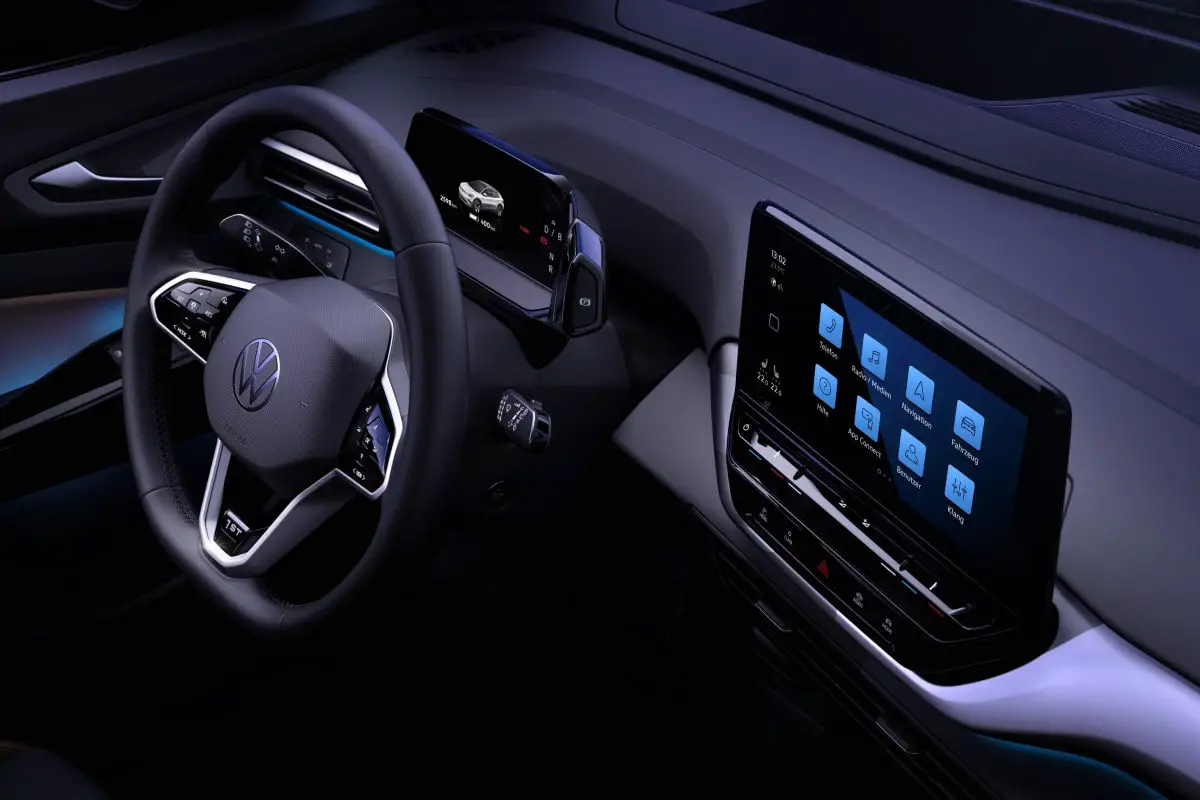
The Volkswagen ID.4 has several driver-assist features, including Adaptive Cruise Control and Lane Keeping Assist . These combine into Volkswagen’s Travel Assist feature, keeping you safe while driving on large highways and freeways.
This article will tell you how to turn them on and briefly overview how to use them.
Table of Contents
How to turn Cruise Control CSS on/off on the ID.4
Standard cruise control – a system in many modern cars – can be turned on at the multifunction steering wheel.
- This activates the system but doesn’t store a speed. Cruise control isn’t currently doing anything.
- Reach the desired speed using the accelerator pedal.
- Select Set .
Cruise control is now active. The VW ID.4 will maintain the current speed as closely as possible.
CSS isn’t Adaptive Cruise Control (see below)! The car won’t automatically slow down as it approaches other vehicles, traffic lights, or objects!
Use the + and – buttons to change the stored speed.
- Tap the + button to increase speed by 1 mph.
- Hold the + button or swipe from bottom to top to increase speed in increments of 5 mph.
- Tap the – button to decrease the set speed by 1 mph.
- Hold the – button or swipe from top to bottom to reduce the set speed in 5 mph increments.
Use the instrument display to set the distance. There are five settings ranging from close to far away.
- Change these settings using the + and – buttons under Set distance .
Pause the cruise control by either:
- Quicky pressing the cruise control button.
- Tapping the brake.
These options will turn put the system to sleep but store the speed. From here, you can either:
- Resume cruise control at the same speed – press RES.
- Turn it off completely – press and hold the cruise control button.
Turning Adaptive Cruise Control (ACC) on in the ID.4
As you might expect, Adaptive Cruise Control is heavily linked with CSS, the standard cruise control system. Ensure Adaptive Cruise Control (ACC) is on by:
- Tapping or swiping over the MODE button.
- Swipe left or right until you reach ACC .
- Tap or swipe the MODE button once more.
Now, use the cruise control as described above. A green light will show on the dashboard confirming ACC is on and working. Be careful only to use cruise control and ACC in safe situations, such as driving on the freeway. If there are many vehicles around you or you’re going around tight corners, don’t use it. The same applies in adverse weather conditions.
ID.4 – how to turn on Volkswagen Lane Keeping Assist
Lane Keeping Assist is automatically set to On in most countries. It’s also automatically activated as part of Travel Assist. The system uses a radar system located behind the windshield. Dirty glass, adverse weather conditions, or bad road quality can affect the system’s effectiveness. Always be aware! You can switch Lane Keeping Assist on and off in the settings menu.
- The light will be green when the Lane Keeping Assist is active and working .
- When it’s yellow , it’s actively altering your positioning with corrective steering.
- If it’s yellow and you see a “!” mark, the system isn’t working .
How to turn on Volkswagen Travel Assist in the VW ID.4
Travel Assist is a semi-self-driving system. It uses the same sensors as ACC and Lane Keeping Assist.
- This is located beneath the RES button.
- A message and green activation light should let you know when the system is active. Turn the system off if you don’t see this message, or a yellow light with a “!” pops up.
Travel Assist will now combine Adaptive Cruise Control and Lane Keeping Assist to keep you driving safely on the freeway. You can always seize control at any moment through the steering wheel or pedals.
Making the most of driver assists for the Volkswagen ID.4
As always, stay aware! You should always be watching out for hazards and potentially dangerous situations. The car doesn’t always get it right. Otherwise, enjoy the benefits and safety nets the driver assist features can bring you.
Check out these pages from the ID.4’s owner’s manual here.
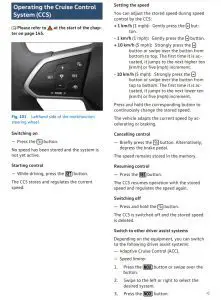
- #Lane Keeping Assist
- #Travel Assist
- #Volkswagen ID.4
- #VW driver assist
12 Myths About Electric Vehicles: Debunked
How to replace the battery in the nissan leaf…, how to activate party mode on tesla model x, one reply to “how to turn off/on driver assist on volkswagen id.4”.
Thanks for your blog, nice to read. Do not stop.
Leave a Reply Cancel reply
Your email address will not be published. Required fields are marked *
Save my name, email, and website in this browser for the next time I comment.
Never miss a story from us, get weekly updates in your inbox.

IMAGES
VIDEO
COMMENTS
Travel Assist's functions include (besides ACC), greater autonomous control of the accelerator, brake and steering, especially when driver inactivity is detected and the car predicts an emergency situation is coming. It's activated by a button mounted on the steering wheel of your ID.3 or ID.4, symbolized by a car in lane with a speedometer ...
The Volkswagen Travel Assist feature is a semi-automated driving assistant that reduces driver workload, fatigue, and helps to mitigate accidents caused by driver inactivity or medical emergencies. ... Build your ID.4. Start building. Ownership benefits, 1 of 3. Shop Models, 2 of 3. Build your ID.4, 3 of 3. Ownership benefits. Go to owner benefits.
Travel Assist is the self-driving driver-assist program found in the VW ID.4. It's supposed to be a driver aid rather than a complete self-driving tool. Turning these advanced features on and off can be difficult. On this page, you'll find instructions for turning Travel Assist on and off. What is Travel Assist on the VW […]
Testing the Lane Assist (LA) and Travel Assist (TA) at the same corner and same speed and lets see what the Real differnces are. If you want to exactly know ...
"Travel Assist with Swarm Data" *. "Travel Assist with Swarm Data"*, which will also follow after the market launch, is another high-end assistance system. It actively keeps the ID.4 Pro 4MOTION in the centre of its lane; to do so, it adapts the driving and can guide the car to the left or right within its lane. It can also maintain a ...
This is a short demo of the VD ID.4 Travel Assist feature -- where the ID.4 will maintain speed and steer the car to stay in lane for you.
Travel Assist 2.5 for the Volkswagen ID.4 can increase driving comfort on longer distances. The Feature Video shows the different functions of the driving as...
VW's Travel Assist is the branded name for the company's Level 2 autonomous driving system, which works at speeds that range from 0-95 mph. Travel Assist uses both the adaptive cruise control ...
Furthermore, the advanced IQ.DRIVE® driver assistance suite is standard on every ID.4 model, featuring Travel Assist 2.0 with adaptive cruise control, Lane Keeping System (Lane Assist), Adaptive Cruise Control with Stop and Go, Traffic Sign Recognition, and Emergency Assist 3.0. New for 2023, ID.4 adds Park Assist Plus with Memory Parking and ...
IQ.Drive assist systems make driving an even more relaxed experience and this particularly applies to Travel Assist. Software and hardware in the ID.4 have been designed as part of a completely new architecture, making it possible for customers to download updates to the car after the purchase.
Travel Assist, standard on ID.4, enables semi-automated hands-on driving capability from 0 to 95 mph. Travel Assist can be activated by a button on the steering wheel, and uses the Adaptive Cruise Control (ACC) and Lane Assist (Lane Keeping Assist) features to help to steer as well as accelerate and brake the vehicle in response to traffic and ...
About Press Copyright Contact us Creators Advertise Developers Terms Privacy Policy & Safety How YouTube works Test new features NFL Sunday Ticket Press Copyright ...
On the ID.4, lane-keep assist is the gentle nudge on the wheel when the car thinks you're too close the edge of the lane. Travel assist uses lane-centering, and you're probably right: you have use adaptive cruise control by itself, but lane centering requires adaptive cruise control to be used with it.
ID.4 Travel Assist / Lane Assist. Picked up my ID.4 on Monday, have driven maybe 100 mi so far and am really enjoying the experience. However, I've noticed that Lane Assist is very unreliable and more hazard than help - definitely not lane centering as promised and actually worse than in my e-Golf.
To help you better manage these situations, Volkswagen has developed advanced driver - assistance technology called IQ.DRIVE. 1. Available on most 2022 Volkswagen vehicles and standard on the 2022 Volkswagen Arteon and ID.4 EV, IQ.DRIVE offers innovative features designed for convenience and peace of mind. The system can alert you to obstacles ...
And I was able to get travel assist working the first time I drove ID.4. Easy. Top right: Fully enables or disables the functionality of (adaptive) cruise control. You can disable it in case you don't want to accidentally set cruise control randomly. Top center: Increase speed. Middle right: Resume button.
The trailer tow bar and wiring socket came today from etrailer.com. The wiring works easily - VW sells the 7-pin socket for $57. The same piece sells at etrailer for $12.04. We also got a 7-pin to 4-pin adapter, made by the same company, and it has a catch on it, that holds it in place when it is plugged in.
The Volkswagen ID.4 has several driver-assist features, including Adaptive Cruise Control and Lane Keeping Assist. These combine into Volkswagen's Travel Assist feature, keeping you safe while driving on large highways and freeways. This article will tell you how to turn them on and briefly overview how to use them. How to turn Cruise Control CSS […]
Travel Assist, standard on ID.4, enables semi-automated hands-on driving capability from 0 to 95 mph. Travel Assist can be activated by a button on the steering wheel, and uses the Adaptive Cruise Control (ACC) and Lane Assist (Lane Keeping Assist) features to help to steer as well as accelerate and brake the vehicle in response to traffic and ...
Comparing VW ID4 Travel Assist on a winding highway. Compare performance with the video from the Tesla Model 3 Autopilot, as these system have the same funct...
My Last video about testing the Lane Assist (LA) and Travel Assist (TA) had reactions that it wasn't done good and the way I did the test favors TA by a big ...